
About UsThe Numismatic Bibliomania Society is a non-profit organization devoted to the study and enjoyment of numismatic literature. For more information please see our web site at coinbooks.org SubscriptionsThose wishing to become new E-Sylum subscribers (or wishing to Unsubscribe) can go to the following web page link MembershipThere is a membership application available on the web site Membership Application To join, print the application and return it with your check to the address printed on the application. Membership is only $20 to addresses in the U.S., $25 for First Class mail, and $30 elsewhere. For those without web access, write to: David M. Sundman, Treasurer
AsylumFor Asylum mailing address changes and other membership questions, contact David at this email address: dsundman@LittletonCoin.com SubmissionsTo submit items for publication in The E-Sylum, just Reply to this message, or write to the Editor at this address: whomren@gmail.com BUY THE BOOK BEFORE THE COIN |
- WAYNE'S WORDS: THE E-SYLUM AUGUST 9, 2015
- REMINDER: NBS EVENTS AT THE 2015 ANA CONVENTION
- KOLBE & FANNING BOOTHS AT 2015 ANA CONVENTION
- SKLOW MAIL BID SALE #26 CLOSES OCTOBER 10, 2015
- BALDWIN'S TO SELL THE PROSPERO LIBRARY IN 2015
- HOW RIDDELL'S 1845 MONOGRAPH ILLUSTRATIONS WERE MADE
- ARTICLE HIGHLIGHTS DEALER JEFF GARRETT
- FRANCIS PAUL PRUCHA, 1921-2015
- NOTES FROM E-SYLUM READERS: AUGUST 9, 2015
- JAMESTOWN ARCHAEOLOGISTS FIND IRISH PENNIES
- COINS IN THE EARLY ENGLISH SETTLEMENT AT JAMESTOWN
- NUMISMATIC BOOKIE: 'TREASURE IN THE CELLAR'
- CENTRAL STATES AUTHOR GRANTS
- QUERY: CHESS-PLAYING AMERICAN NUMISMATISTS SOUGHT
- PETE SMITH ON DECODING THE SLAB
- MORE ON ENGRAVER EMIL SIGEL AND HIS BROTHER FRANZ
- BENJAMIN T. WALTON AND RARE GOLD COINS
- HOLABIRD WESTERN AMERICANA AUCTION SEPTEMBER 2015
- HARVEY STACK ON THE PRINTED WORD IN NUMISMATICS
- LEOMINSTER ROMAN COIN HOARD FOUND
- RARE SOLIDUS OF EMPEROR HONORIUS OFFERED
- BEST. ROYAL. NICKNAME. EVER.
- AN EARLY EMBOSSED NUMISMATIC ILLUSTRATION
- THE IRISH LADY LAVERY BANKNOTES OF 1928-1977
- ALTERNATIVE CURRENCIES: ARTISANAL CASH
- MEDAL TO COMMEMORATE POPE FRANCIS' VISIT TO AMERICA
- 1870 HALF DOLLAR CANCELLED OBVERSE DIE
- TIMES ARTICLE FAVORS KEEPING HAMILTON
- $1 BILL RETAINED OBSTRUCTION ERROR
- WAYNE'S 2015 ANA CONVENTION PRE-DIARY
- MORE 2015 ANA CONVENTION EVENTS
- A NIGHT AT THE SMITHSONIAN COIN EXHIBIT
- FUN WITH FREY: MODERN TAKES ON OLD COIN NAMES
- SYMBOLS ARTS MEDALS, CHALLENGE COINS, AND BADGES
- FEATURED WEB PAGE: THE ROSE STREET SUGAR HOUSE MEDAL
Click here to access the complete archive
To comment or submit articles, reply to whomren@gmail.com
WAYNE'S WORDS: THE E-SYLUM AUGUST 9, 2015

New subscribers this week include: Scott Thompson. Welcome aboard! We now have 1,853 subscribers.
This week we open with events at this week's ANA convention, updates on numismatic literature sales by David Sklow and Baldwin's, and information on the printing of Riddell's Monograph.
Other topics include Jeff Garrett, author Francis Paul Prucha, coin discoveries at Jamestown, chess-playing numismatists, engraver Emil Sigel, a new Roman coin hoard, Leo the Hogmouth, retained obstruction errors, challenge coins and badges.
To learn more about the Saddle Ridge Treasure find, Ed Frossard’s offering of works by John Trumbull, the Prospero Library, the Baltimore gold rush, the 1796 quarter eagle, mandibular prognathism, embossed numismatic illustrations, David Bowie money and squiddish, read on. Have a great week, everyone!
Wayne Homren
Editor, The E-Sylum
REMINDER: NBS EVENTS AT THE 2015 ANA CONVENTION
Thurs., August 13, 11:30 am to 1:00 pm, NBS Symposium, Room 22
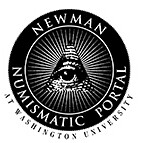 On Thursday, August 13, the Newman Numismatic Portal (NNP) team will present at the NBS Symposium at 11:30AM. This website, funded
by the Eric P. Newman Numismatic Education Society and administered through Washington University in St. Louis, focuses on gathering and preserving
numismatic knowledge for the benefit of all collectors and researchers. Project consultants include well-known bibliophiles Len Augsburger, Roger
Burdette, John Feigenbaum, Wayne Homren, and Joel Orosz. The NNP team will demonstrate the current website and discuss the roadmap going forward.
On Thursday, August 13, the Newman Numismatic Portal (NNP) team will present at the NBS Symposium at 11:30AM. This website, funded
by the Eric P. Newman Numismatic Education Society and administered through Washington University in St. Louis, focuses on gathering and preserving
numismatic knowledge for the benefit of all collectors and researchers. Project consultants include well-known bibliophiles Len Augsburger, Roger
Burdette, John Feigenbaum, Wayne Homren, and Joel Orosz. The NNP team will demonstrate the current website and discuss the roadmap going forward.
Thurs., August 13, 1:00 to 2:30 pm, NBS Board Meeting, Room 24 (open to the public)
Friday, August 14, 11:30 am to 1:00 pm, NBS General Meeting, Room 5
On Friday, August 14, Dr. Donald Kagin will be our featured speaker at the NBS General Meeting at 11:30 am. Dr. Kagin will be discussing his new book, Profit from Gold and Rare Coins Now, and he will also be speaking about the Saddle Ridge Treasure find from his unique perspective. There will also be reports from the NBS Officers, our annual fundraising auction with several rare and attractive titles, and a few surprises.
To view the complete convention schedule of events, see:
/www.money.org/worldsfairofmoney/schedule
To read a list of speaker presentations compiled by the local host committee, see:
2015 World’s Fair of Money — Schedule of Club Speakers
(www.chicagocoinclub.org/events/2015/ana/club_mtgs.html)
KOLBE & FANNING BOOTHS AT 2015 ANA CONVENTION
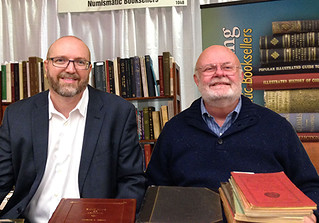 Kolbe & Fanning Numismatic Booksellers will be participating in this year’s American Numismatic Association World’s Fair of Money, August
11-15 in Rosemont, Illinois. We will have a double booth (533-534) and are bringing hundreds of selections from our stock of new, used and rare books
on coins from around the world. In addition to items listed in our extensive online inventory, we are bringing a very nice group of fresh material
that will be offered for the first time at the show.
Kolbe & Fanning Numismatic Booksellers will be participating in this year’s American Numismatic Association World’s Fair of Money, August
11-15 in Rosemont, Illinois. We will have a double booth (533-534) and are bringing hundreds of selections from our stock of new, used and rare books
on coins from around the world. In addition to items listed in our extensive online inventory, we are bringing a very nice group of fresh material
that will be offered for the first time at the show.
A few highlights include:
- The very rare plated catalogue of the Carlos de Beistegui collection
- The Duke of Devonshire’s exceptional copy of the 1532 Paris edition of Budé
- Ed Frossard’s very rare and controversial offering of works by John Trumbull
- Possibly the only 18th-century account of a coin cabinet formed by an American collector
- An extraordinary volume of pamphlets by Augustin Dupré regarding his role in French coinage, from the library of the author.
In addition, we are bringing with us a remarkably varied offering of ephemera, numismatist’s medals, postcards, scrip, and other items illustrating the history of the hobby.
Finally, we will be offering Richard Margolis’s new publication on Nini’s terra cotta medallions depicting Benjamin Franklin at a sale price of $150. This offer is good only at the show and in person and is on a cash-and-carry basis.
We look forward to seeing old friends, making new ones and participating in this year’s NBS events. Please stop by and say hello!
SKLOW MAIL BID SALE #26 CLOSES OCTOBER 10, 2015
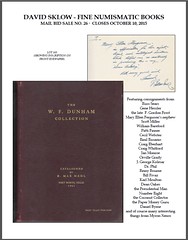 Highlights for Numismatic Literature Mail Bid Sale # 26 closing October 10th are listed below, the catalog is at the printing company and
should be posted on our web site Monday or Tuesday.
Highlights for Numismatic Literature Mail Bid Sale # 26 closing October 10th are listed below, the catalog is at the printing company and
should be posted on our web site Monday or Tuesday.
Look the list over carefully, there are some gems in there!
- Authors proof An Illustrated History of U. S. Loans 1775-1898 by Gene Hessler.
- Secretary of the Treasury, William McAdoo, letter dated December 1917.
- The American, newspaper vol. I No. 173. September 1820, article concerning counterfeits.
- One lot of ephemera from The Money Tree, Myron Xenos & Ken Lowe.
- Editors proof pages of Edmund Roberts and The Rare Silver Dollars Dated 1804, by Q. David Bowers, 1999.
- The Asylum, journal of the Numismatic Bibliomania Society, Vol. I through Vol. XXX complete.
- The Shekel, journal of the American Israel Numismatic Association, Vol. I through Vol. XXXII complete and uniformly bound in original blue cloth.
- American Red Cross in World War II - Collectors' Guide, by Jim Aitken, Garry Arva, and Kathy Freeland, special numbered MPC Fest edition # 31 of 40.
- B. Max Mehl's personal copy the Kosoff sale of William P. Donlon, personally inscribed to Max by Abe Kosoff.
- The magnificent deluxe full leather edition of the B. Max Mehl sale of the William Forrester Dunham Collection, personally inscribed by Max to his Executive Secretary, Mary Ellen Ferguson and her name in gilt on front!
- The magnificent deluxe full leather edition of the B. Max Mehl sale of the William Cutler Atwater Collection, personally inscribed by Max to his Executive Secretary, Mary Ellen Ferguson and her name in gilt on front!
- Numerous early edition, and special edition Redbooks, by R.S. Yeoman and Kenneth Bressett.
- Das Ordenbuch Der Gewesenen Osterreichisch - Ungarischen Monarchie, 1918-1919, magnificent plates and text, house in two large folio archival binders, the medal book of the Austro-Hungarian Empire.
- Numismatic Scrapbook, Vol. I & II by Lee F. Hewitt, 1935 and 1936.
- The Shipmaster's Manual for the Exchange of Monies in the Ports of all Nations, by W. H. Rosser, 1876.
- Numismatic Scrapbook, Vol. VI, VII, IX & X by Lee F. Hewitt, 1940, 1941, 1943 and 1944, all in original covers .
- The Art and Craft of Coinmaking: A History of Minting Technology, Denis R. Cooper, 1988.
- Numerous works on treasures and shipwrecks.
- 1794 the History and Genealogy of the First United States Dollar, by Jack Collins and Walter Breen, 2007, one of 99 copies.
- The Gardner Collection: Barber Quarters 1892-1916, by Eugene Gardner, 2011, deluxe in slipcase.
- Numismatica Americana: The John J. Ford, Jr. Reference Library, sales by George Frederick Kolbe, Part I & II deluxe editions in quarter leather.
- Journals of the Lewis and Clark Expedition, by Gary E. Moulton, Vol. I through Vol. XIII, complete, volume one is elephant folio, volumes 2-11 & 13 are octavo and volume 12 is quarto.
- Hardbound set three volumes of the Norweb Collection by Bowers & Merena, 1987-1988.
- Essay-Proof Journal , official journal of the Essay-Proof Society, Vol. I through Vol. XXXIII, complete in 132 whole numbers, 1944-1976, uniformly bound in burgundy cloth.
- Fixed price lists of Ed. Frossard 1892-1895.
- Heath Counterfeit Detector, 1864, pocket edition, 10 plates, Newman Type 1-P-14.
- The Fabulous Library of Daniel M. Byrne covering Military Awards, Decorations & Medals.
- Heath Counterfeit Detector, 1866, second edition, 8 plates, Newman variety 2-BH.
- History of the Currency of the Country and of the Loans of the United States from the Earliest Period to June 30, 1900, second edition by William F. De Knight. RARE.
- Heath Counterfeit Detector, third edition 1870, 10 plates, possible Newman 3BH-2 .
- Heath Counterfeit Detector, Banking House edition, 1877, twelfth edition, 11 plates, Newman 12-BH-2.
- Heath Counterfeit Detector, several other examples.
- Run of Manhattan Coin Co. auction catalogs.
- Mason's Coin & Stamp Collectors' Magazine, Mason & Co. 1867-1870 & 1870-1872.
- Numerous Special Edition Redbooks by Yeoman/Bressett.
- The Herman Halpern Collection of United States Paper Money, by Stack's, the special deluxe hard bound edition numbered 26 of 25, the cataloguer's copy.
- Numerous auction catalogs from the nineteenth century.
- Letter from Ken Lowe [on official Money Tree Letterhead] to Craig Whitford [1994 ANA General Chairman], explaining how great the 1994 Detroit convention was, and quoting Mr. "T" as to "I pity the fools" who did not attend!
- A glass negative/slide of "Ye Olde Mint" of the classic Newell & Sons photograph.
- Steel roller die with four images for elongated coins celebrating the Philadelphia Mint Bicentennial.
- Two different macerated money post cards.
- A signed by Farran Zerbe, souvenir of the 1922 New York ANA convention.
- Two Hundred lots of small stature numismatic works from the library of Myron Xenos, individually listed!
- Run of Bolender auction catalogs, as one lot.
- Run of Thomas Elder auction catalogs as one lot.
- Long run of The Standard Catalogue of United States Coins, by Wayte Raymond, 1936-1957.
- Very nice offering of volumes of The Numismatist 1920's- 1940.
- A California Gold Rush History: Featuring the Treasure From the S.S. Central America, by Q. David Bowers, 2002, the Super Deluxe Full Leather edition in slipcase, numbered 191, with actual photographs in pocket on back pastedown, and gold dust behind a mica window.
- The Asylum, journal of the Numismatic Bibliomania Society, Jack Collins Co-Founder, his personal set, two bound volumes in blue cloth, with Jack's bookplate, 1980-1992, vol. I through vol. X.
- Long run of Barney Bluestone auction catalogs.
- The CherryPickers Guide to Rare Die Varieties, fourth edition, 2000, volume one, Bill Fivaz's editors proof copy.
- Numerous deluxe bound nineteenth century auction catalogs from Karl Moulton.
- Very rare, J.A. Bolen's Medals, Cards, and Fac-Similes, by Edwin L. Johnson, 1882, copy no. 82, with annotations.
- Very Early Newspapers with Numismatic Content.
- 1947 ANA Convention Medal Set, Bronze, Silver & Gold medals.
- And much, much more!
David Sklow-Fine Numismatic Books
P.O. Box 6321
Colorado Springs, CO 80934
PH: 719-302-5686
FAX: 719-302-4933
Email: numismaticbooks@aol.com
Web Site: FineNumismaticBooks.com

BALDWIN'S TO SELL THE PROSPERO LIBRARY IN 2015
The Prospero Library – one of the most prestigious and important libraries to appear on the market for many years. In 2012, A H Baldwin & Sons Ltd sold the magnificent Prospero Collection of Ancient Greek Coins at our New York Auction.
Now, in 2015, we are delighted to announce the upcoming sale of the accompanying library.
The library contains many of the standard reference works for Greek Coins, many of which are beautifully bound by the renowned bookbinders Sangorski and Sutcliffe.
The majority of this library is in superb condition, with several volumes that are extremely rare. In preparation for the release of the Fixed Price List for this wonderful collection, here is an exclusive preview into just some of the wonderful items available.
Rizzo, Monete Greche Della Sicilla
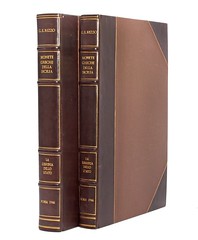 Rizzo, G.E. Monete Greche Della Sicilla.
Rizzo, G.E. Monete Greche Della Sicilla.
Rome, 1946, two volumes.
Both volumes finely bound by Sangorski and Sutcliffe in half dark brown morocco and cloth boards. Raised bands to spine, ruled and lettered in gilt. Top edges gilt. Hand marbled endpapers. Very seldom seen and most highly sought after. Rare and important.
Number 387 of a limited run of 425 – ‘…a very detailed work that is the most complete and easiest to use…Because this was published while the ashes of war were still settling, it is quite rare and in extreme demand’.
Seltman, Temple Coins of Olympia
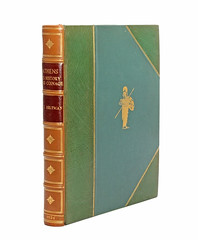 Seltman, C.T. The Temple Coins of Olympia
Seltman, C.T. The Temple Coins of Olympia
Cambridge 1921. Both parts bound into a single volume of half green morocco and buckram boards with two-line gilt panelling. A very fine copy of this key reference, seldom seen.
‘A detailed examination of the coinage which had traditionally been attributed to the city of Elis’
Babelon, Monnaies Grecques et Romains
Babelon, E. Traite des Monnaies Grecques et Romains
Paris, 1901-1933.
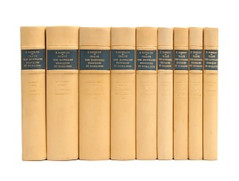 Complete in five text volumes and four plate volumes. Elegantly bound by Sangorski and Sutcliffe in quarter cream goat and blue cloth
boards.
Complete in five text volumes and four plate volumes. Elegantly bound by Sangorski and Sutcliffe in quarter cream goat and blue cloth
boards.
beautiful and complete set of Babelon's monumental work. Complete sets are seldom seen, especially in such a fine condition as here.
McClean Collection of Greek Coins
Grose, S.W. Catalogue of the McClean Collection of Greek Coins, Vols 1-3
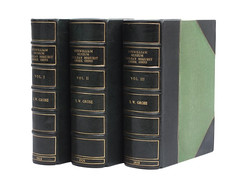 Complete in 3 volumes, uniformly bound in dark green morocco and matching cloth boards.
Complete in 3 volumes, uniformly bound in dark green morocco and matching cloth boards.
A superb record of this remarkable collection, listing over 10,000 coins, now housed in the Fitzwilliam museum.
The Prospero Library Fixed Price List will be released early September 2015 - for regular updates, including sneak previews from the sale, visit our website at www.baldwin.co.uk, or contact our numismatic specialist Caroline Holmes at caroline@baldwin.co.uk
HOW RIDDELL'S 1845 MONOGRAPH ILLUSTRATIONS WERE MADE
Regarding Riddell's A Monograph of the Silver Dollar, Good and Bad, Bob Leonard writes: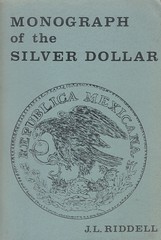 I have copy No. 34 of Gary Beals reprint. Apparently he did not read it all the way to the end, for in Concluding Remarks, (inking is weak
here, though) Riddell explained his way of preparing the illustrations. He rejected the method of medal rule used by Eckfeldt and Dubois, because it
"necessarily obliterates or distorts the more minutely engraven details . . . which details are sometimes essential in deciding whether a coin
be good or bad. After many trials . . . I at length succeeded in preparing metal types adapted for printing, indirectly from the coins themselves . .
."
I have copy No. 34 of Gary Beals reprint. Apparently he did not read it all the way to the end, for in Concluding Remarks, (inking is weak
here, though) Riddell explained his way of preparing the illustrations. He rejected the method of medal rule used by Eckfeldt and Dubois, because it
"necessarily obliterates or distorts the more minutely engraven details . . . which details are sometimes essential in deciding whether a coin
be good or bad. After many trials . . . I at length succeeded in preparing metal types adapted for printing, indirectly from the coins themselves . .
."
The original edition is printed on rectos only. My impression is, and I hope that George Kolbe or someone who possesses a copy of it, can confirm this, that it was run through the press twice: once in the usual manner for the text, and a second time for the illustrations, the metal type for the illustrations being BELOW the paper and the ink above, giving the "rubbing-like" appearance Gary mentions.
Riddell apologized for this: "if they do not always make a handsome print, give a perfectly correct . . . representation." In other words, in Monograph of the Silver Dollar you are looking at a slightly blurred image of the coin itself, not a drawing, and can pick out points for comparison with perfect confidence. While we could wish for better pictures, this is an amazing breakthrough in counterfeit detection.
To read the complete article, see:
MORE ON RIDDELL'S 1845 MONOGRAPH
(www.coinbooks.org/esylum_v18n31a29.html)
ARTICLE HIGHLIGHTS DEALER JEFF GARRETT
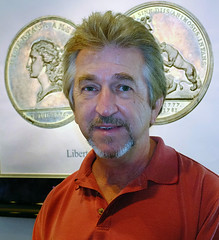 When Jeff Garrett was about 12 years old, he was given an album so he could start collecting Lincoln head pennies. But unlike many other
boys in the 1970s, he never stopped.
When Jeff Garrett was about 12 years old, he was given an album so he could start collecting Lincoln head pennies. But unlike many other
boys in the 1970s, he never stopped.
His hobby became a passion, then a business. For more than 30 years, Garrett has owned one of the nation's largest dealerships, Mid-America Rare Coin Galleries in Lexington.
"I love the thrill of the chase," he said. "When I finished that first album, I wanted to do another album. When I start something I just get obsessed by it."
Garrett, 57, is the author of many books about rare coins. He is on the advisory board of the Smithsonian Institution's Museum of American History, where he helped organize the rare coin exhibit that opened in July. On Aug. 12, he will begin a two-year term as president of the American Numismatic Association, the nation's largest organization of coin collectors with about 25,000 members.
"I've been lucky," he said. "I've been able to turn a hobby into a living."
The ANA presidency is an unpaid job that comes with a lot of responsibility: the 124-year-old organization has a $6 million annual budget and more than 30 employees. Its mission is numismatic education and promoting the hobby.
Garrett said he is proud to head the organization responsible for his first airplane trip. As a boy, he won a scholarship to an ANA summer seminar in Colorado Springs, the organization's headquarters.
"That really helped jump-start my interest in coins," he said, adding that the organization gives away 50 seminar scholarships each year to young collectors.
His main goal as ANA president is to bring more young people into the hobby — and bring back "dormant" collectors who lost interest or got busy with other things.
Much of Garrett's work is buying and selling coins with other dealers around the country and doing appraisals.
"Sometimes a rare coin might show up that hasn't been around for 20 years and you've got to do some research and find out how really rare it is," he said. "It's one of the things I love about my business. Every day is almost like an Antiques Road Show."
Garrett specializes in American gold coins, which were made from 1795 until 1933. They are rare because, during the Great Depression, federal officials urged people to turn them in so they could be melted into bars and stored at Fort Knox.
"That gold would be worth a whole lot more if they had just put the coins in bags and stashed them away," he said.
To read the complete article, see:
Tom Eblen: For owner of rare coin shop,
'every day is almost like Antiques Road Show' Read more here:
http://www.kentucky.com/2015/08/02/3970967_tom-eblen-for-owner-of-rare-coin.html?rh=1#storylink=cpy
(www.kentucky.com/2015/08/02/3970967_tom-eblen-for-owner-of-rare-coin.html?rh=1)
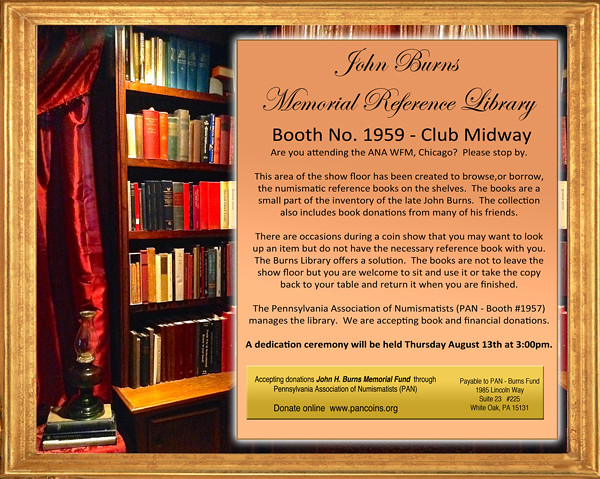
FRANCIS PAUL PRUCHA, 1921-2015
John T Bolger writes:
Fr. Francis Paul Prucha, S.J., the author of the superb standard research, reference, and generally delightful to read text, Indian Peace Medals in American History, first published in 1971, has died. His scholarship and prolific writing went far beyond our little corner of Numismatic Americana. I knew him not except by name and deed so have attached links to a local obituary and his Wikipedia listing.
 Fr. Prucha was called to eternal life during his sleep on July 30, 2015.
Fr. Prucha was called to eternal life during his sleep on July 30, 2015.
He was the oldest member of the Wisconsin Province, a Jesuit for 64 years and a priest for 58 years. Fr. Prucha was born in River Falls, Wisconsin on January 4, 1921. He graduated from River Falls State Teachers College in 1941 and served in the Army Air Corp from 1942 to 1946. He earned an M.A. in History from the University of Minnesota and a Ph.D. in History from Harvard University. In 1950 Fr. Prucha entered the Society of Jesus and was ordained a priest in 1957.
An outstanding Jesuit Scholar and Educator, Fr. Prucha was assigned to Marquette University in 1960. He remained at Marquette for fifty years even after he officially became professor emeritus. Fr. Prucha trained generations of doctoral students, published more than twenty-five books, many scholarly articles and was a major force in establishing Marquette’s rich research archives documenting Catholicism among Native Americans. His two-volume, The Great Father: The United States Government and the American Indians, published in 1985, is regarded as a classic among professional historians.
To read the complete article, see:
Fr. Francis Paul Prucha, S.J.
(http://beckerritter.com/sitemaker/memsol.cgi?user_id=1635548)
Prucha was born in River Falls, Wisconsin, the first son to Edward J. and Katharine Prucha and the older brother of John J. Prucha. He graduated from River Falls High School at the age of 16 in 1937 as Paul Prucha and was then educated at Wisconsin State Teachers College, at River Falls, which awarded him a Bachelors of Science degree in 1941. After a year and a half of high school teaching and then three and a half years of service in the United States Army Air Force, he enrolled in the University of Minnesota and received an M.A. degree in 1947.
Harvard University awarded him a Ph.D. degree in history in 1950 under the direction of Frederick Merk. His dissertation, a study of the role of the peacetime army in the settlement process, was published in 1953 as Broadax and Bayonet: The Role of the United States Army in the Development of the Northwest, 1815-1860.
Prucha joined the Society of Jesus in 1950 and was ordained in 1957 after studying at Saint Louis University and Saint Mary's College in St. Marys, Kansas. Three years later he began teaching at Marquette and is remembered by generations of alumni as a model of the teacher-scholar. Since 1960 he has been on the history faculty at Marquette University. He has served as visiting professor at the University of Oklahoma and at Harvard and was the Gasson Professor at Boston College.
When the editor of Marquette Magazine recently asked readers to write about their greatest teachers, Father Prucha was identified among a group of classroom legends. "Of all the teachers I've had," wrote Richard Hryniewicki (A&S '61, MA '63), "Father Prucha did the most to instill a love of learning, a quest for knowledge, and practicing work ethic."
In the late 1960s, while studying under a Guggeheim Fellowship, Prucha began work on a comprehensive history of U.S. Indian policy. His research culminated with the two-volume The Great Father: The United States Government and the American Indians. The book was a finalist for the Pulitzer Prize in history in 1985 and is regarded as a classic among professional historians. The Great Father was awarded the Billington Prize by the Organization of American Historians in 1985. The recipient of six honorary degrees, Prucha was awarded his emeritus appointment in 1988.
Father Prucha is also the author or editor of 25 other books of numerous articles, and scores of book reviews. He is known internationally for his expertise on the American West and United States policy towards Native Americans. Prucha also helped to establish Marquette’s rich research collections documenting Catholicism among Native Americans. As a tribute to Prucha, Marquette University's Archives and Special Collection's reading room in its newly constructed Raynor Library was named in his honor. Father Prucha was also inducted into the Milwaukee Central Library’s Wisconsin Writers Wall of Fame.
Prucha was instrumental in acquiring for Marquette University the records of the Bureau of Catholic Indian Missions. There is also a collection that relates purely to Prucha and his work. The archival collections of Francis Paul Prucha includes his correspondence, books (1950–2002), articles, book reviews (1942–2002), public talks and lectures (1956–1998), courses taught (1952–1987), awards and honors (1971–2003), professional activities, research fellowships and grants (1954–2003), personal papers (1927–1993), and research materials (1955–2003).
To read the complete article, see:
Francis Paul Prucha (https://en.wikipedia.org/wiki/Francis_Paul_Prucha)
NOTES FROM E-SYLUM READERS: AUGUST 9, 2015
1919 Double Struck Buffalo Nickel

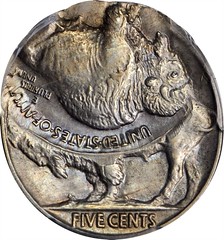
Nick Graver writes:
I just had to say that the double struck Buffalo was one of the most fantastic pieces I’ve ever encountered! Sure, they had to exist, but never have I seen such an item. And the crude Jola coin sure was a treat.
To read the earlier E-Sylum article, see:
SELECTIONS FROM THE STACK'S BOWERS ANA RARITIES SALE
(www.coinbooks.org/esylum_v18n31a21.html)
Numismatics in 'The Hucksters'
Alan V. Weinberg writes:
Relative to the recent E-Sylum segment on the Hurd Hatfield character being a numismatist in The Picture of Dorian Gray, I watched Turner Classic Movies' "The Hucksters" (1947) last night , a movie I'd seen perhaps twice before. It starred Clark Gable, Adolphe Menjou and Sydney Greenstreet . Menjou and Gable had appeared in at least six pictures together going back to the silent era when Menjou was a major star and Gable an extra so they were comfortable with each other.
In one of the first movie scenes in Hucksters, Gable is well dressed and sitting for a job interview with ad agency boss Menjou. During this interview Menjou points to Gable's neck tie and says "By the way, I like your tie." to which Gable replies "I thought you would". Gable is wearing a tie with an array of $20 gold pieces on it. It is pretty clear these two veteran actors and longtime friends were engaging in an unscripted banter.
Menjou auctioned his coin collection in 1950 through Beverly Hills Coin Galleries, Kreisberg and Kosoff. He died in 1963 in Beverly Hills.
To read the earlier E-Sylum articles, see:
THE PICTURE OF DORIAN GRAY, NUMISMATIST
(www.coinbooks.org/esylum_v13n20a27.html)
NOTES FROM E-SYLUM READERS: JUNE 28, 2015 : Numismatics in The Picture of Dorian
Gray? (www.coinbooks.org/esylum_v18n26a09.html)
NUMISMATICS IN THE PICTURE OF DORIAN GRAY
(www.coinbooks.org/esylum_v18n28a27.html)
Buffalo Nickel Charm Bracelet
Hadrien Rambach forwarded this found image of a piece of jewelry made from a Buffalo Nickel. Thanks.
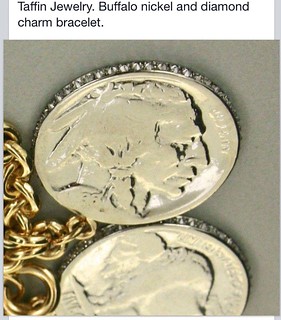
Summer Reading: Operation Bernhard
Dave Hirt writes:
While many of you are traveling to the ANA convention this week, I will be traveling back home to Frederick, MD. I had a good time here in Europe. I wanted to comment on the Operation Bernhard post. I brought two books on that subject from my library that I read while here. I really enjoyed both of them. One was Krueger's Men by Lawrence Malkin, the other was the English translation of Counterfeiter by Moritz Nachtstern, of which in Malkin wrote a forward.
In Malkin's book the whole wartime counterfeiting plan is laid out. The idea of counterfeiting Germany currency was suggested in both Britain and the USA, but in both countries, treasury and bank officials vetoed it.
In Germany it was the idea of Heinrich Himmler who had a never ending need for money for his SS operations. SS major Bernard Kruger was picked to run this operation, using Jewish prisoners from the many concentration camps. They were successful, making nearly perfect British pound notes that spread throughout Europe causing the Bank of England problems for a long time. Amazingly, Bank of England officials trying to protect their own reputations denied the problem, and then covered it up for many years.
The other book is the story of Moritz Nachtstern, a Norwegian Jew who was half dead in Auschwitz when Krueger picked him because he was a typographer. He then went to the Sachsenhausen camp, Block 19,the place of the counterfeiting. He tells of his experiences of the next two years.
While the Sachsenhausen camp was not a death camp like Auschwitz, it was no country club. The prisoners were subject to brutal beatings, and constant harassment of maliciousness SS guards. They were all marked for death to keep the operation secret, but some good luck and the fast collapse of Germany in the last few weeks of the war saved them.
To read the earlier E-Sylum article, see:
OPERATION BERNHARD SURVIVOR HANS WALTER
(www.coinbooks.org/esylum_v18n31a33.html)
Typo: Ken Hallenbeck
Rich Hartzog noticed a misspelling of Ken Hallenbeck's name in the article on Byron M. Pickett. Sorry I missed it. We'll fix it in
our archive. Thanks.
To read the earlier E-Sylum article, see:
MORE ON LINCOLN MEDALIST BYRON M. PICKETT
(www.coinbooks.org/esylum_v18n31a30.html)

JAMESTOWN ARCHAEOLOGISTS FIND IRISH PENNIES
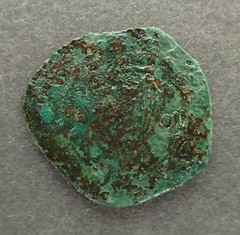 The excavation of the cellar of a building and a well that stood outside of the walls of James Fort has yielded Irish pennies, minted by
the English between 1601 and 1602. The coins fell into disuse when the Irish rejected them, however. Mary Outlaw, curator of collections for the
Jamestown Rediscovery Project, told WYDaily.com that one of the earliest colonists, the son of an official at the Royal Mint, may have brought the
coins to the colony, since more Irish pennies have been found on Jamestown Island than anywhere else in the world. The team has also recovered the
matchlock firing mechanisms for two muskets.
The excavation of the cellar of a building and a well that stood outside of the walls of James Fort has yielded Irish pennies, minted by
the English between 1601 and 1602. The coins fell into disuse when the Irish rejected them, however. Mary Outlaw, curator of collections for the
Jamestown Rediscovery Project, told WYDaily.com that one of the earliest colonists, the son of an official at the Royal Mint, may have brought the
coins to the colony, since more Irish pennies have been found on Jamestown Island than anywhere else in the world. The team has also recovered the
matchlock firing mechanisms for two muskets.
Jamestown Rediscovery archaeologists may have been busy identifying the four founders of the Jamestown colony who were unearthed in gravesites under the church for the past 20 months, but that did not stop them from continuing to dig elsewhere.
Work continues to excavate what is believed to be the cellar of a building that once stood outside the walls of James Fort. The team has been working on the area since last year, digging through an area believed to be a well.
In the last month, the cellar has produced several noteworthy artifacts, including gun parts and rare coins.
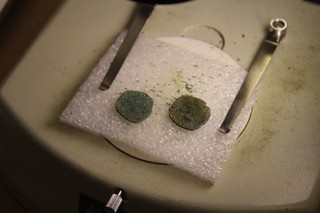 The coins are what is known as Irish pennies. The English minted them in 1601 and 1602 and tried to introduce them as currency in Ireland,
however the Irish rejected the coins and they quickly fell into disuse.
The coins are what is known as Irish pennies. The English minted them in 1601 and 1602 and tried to introduce them as currency in Ireland,
however the Irish rejected the coins and they quickly fell into disuse.
Jamestown Island has proven to be the single largest source of the coins in the world, said Merry Outlaw, the curator of collections for the Jamestown Rediscovery Project.
She said the coins may have been brought to Jamestown to be used as an internal currency during the colony’s earliest days. The Irish rejection of the coins left no use for them in the Old World.
One of the earliest colonists was the son of the top official at England’s Royal Mint and may have been the catalyst in getting the coins to the New World. The coins are about the size of a U.S. penny and feature images of harps and Latin writing along the edges.
To read the complete articles, see:
Artifact Update from Virginia’s James Fort
(http://archaeology.org/news/3531-150731-virginia-james-fort)
Jamestown
Unearthed: Archaeologists Find Gun Parts, Rare Coins in Cellar Pit
(http://wydaily.com/2015/07/31/local-news-jamestown-unearthed-archaeologists-find-gun-parts-rare-coins-in-cellar-pit/)
Like all artifacts recovered during our archaeological excavations, coins are cataloged. After cataloging, most artifacts are housed in archival boxes, which go into long term storage with easy access for future specialized studies.
A few representative, special, or unique artifacts from each feature are placed in our readily available study collection. Coins are among the items pulled for our study collection.
Coins are treated by our professionally trained conservation staff when they come into our laboratory. They are cleaned and consolidated using best conservation practices. We do not photograph each one. A few representative examples are on display in our museum, the Archaearium, but most are housed in our study collection.
The early coinage at Jamestown was the topic of an informative and beautifully written doctoral dissertation by Beverly Straube, our former curator. You will find her dissertation at this link: ‘And he that in Virginia shall copper coin receive’ : Explicating an undocumented fiscal scheme in the early English settlement at Jamestown through the archaeological evidence (https://lra.le.ac.uk/handle/2381/28779)
COINS IN THE EARLY ENGLISH SETTLEMENT AT JAMESTOWN
Explicating an Undocumented Fiscal Scheme in the Early English
Settlement at Jamestown through the Archaeological Evidence
by
Beverly Ann Straube
Abstract
Traditionally, coins and exonumia found in archaeological contexts have been examined in a way that fails to utilize their full potential for making substantive contributions to historical questions. Often bearing dates and/or dateable iconography, these numismatic objects are used primarily to provide temporal data for archaeological contexts or sites; and, as material culture related to the economic sphere, the function of these objects is assumed. When archaeological excavations in England’s North American colonies uncover European coins and exonumia that are obsolete in their original countries of origin, they are often interpreted as items imported for the Indian trade without consideration of their full social and cultural contexts.
Since 1994, archaeological excavations on the c. 1607-24 site of James Fort, the initial English settlement at Jamestown, have uncovered over two hundred Dutch and English tokens and Irish coins that are both unusual for the Virginia context and are no longer current in their original settings. This thesis examines this unusual group of base metal coins and exonumia found in the fort’s tightly dated discrete contexts as evidence of an undocumented scheme of token currency in the early English colony.
The research incorporates a biographical approach to the data, weaving together numismatic scholarship, evidence from archaeological contexts, and contemporary historical accounts. The use of token currency in Bermuda and Newfoundland, two early English colonies established subsequent to Jamestown, provides evidence of parallel adaptive measures required to fulfil local needs in New World settlements. In conclusion, familial and commercial links connecting the leaders of the Virginia enterprise, English governmental officials, and the Royal Mint are suggested as agencies for the obsolete coins and tokens at Jamestown. Using numismatic objects as portals to Jamestown’s past, this study demonstrates new understandings may be gained from beginning an historical inquiry with contextually relevant material culture.
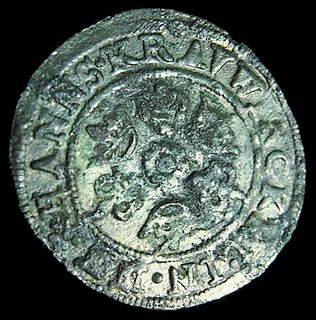
A brass Nuremberg jetton of Hans Krauwinckel II
To read the complete thesis, see:
https://lra.le.ac.uk/handle/2381/28779
NUMISMATIC BOOKIE: 'TREASURE IN THE CELLAR'
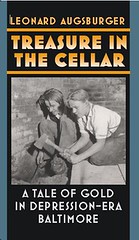 Every child dreams of buried treasure: digging, with your best friend, until your shovels pierce a rotted chest, and a rivulet of gold
coins spills into the fresh dirt. Delightful childhood fantasies, but buried treasure exists only in storybooks, right? Wrong. Two best friends once
unearthed hundreds of gold coins in Baltimore, and not along the waterfront, but in a cellar!
Every child dreams of buried treasure: digging, with your best friend, until your shovels pierce a rotted chest, and a rivulet of gold
coins spills into the fresh dirt. Delightful childhood fantasies, but buried treasure exists only in storybooks, right? Wrong. Two best friends once
unearthed hundreds of gold coins in Baltimore, and not along the waterfront, but in a cellar!
Fourteen-year-old Theodore Jones lived in the tenement apartment building at 132 S. Eden St. He befriended 15-year-old Henry Grob, who lived a block away. On Aug. 31, 1934, the two formed a boy’s club, put the nickel-apiece dues into a cigar box, and decided to bury the box for safekeeping. They descended into the cellar of 132 S. Eden, and dug a hole along a back wall. About a foot down, they hit a corroded gallon-sized can, which, after being struck with an ax, disgorged gold coins!
The boys surrendered these coins, amounting to $11,424 in face value, to the Baltimore Police. A “Baltimore gold rush” ensued, with several people filing legal claims for ownership of the hoard, while others dug through the cellar, hoping to discover treasure the boys had missed. Then, on Sept. 2, 1935, the Jones family apartment at 132 S. Eden was robbed of $3,600, an astonishing sum for such a poor family. The boys explained that this was Theodore’s share of a second discovery they had made in the cellar, in May of 1935, in the only spot that treasure-hunters hadn’t searched. This story seemed fishy, but the boys eventually prevailed in the legal arena, and also won the inevitable appeals. The coins were auctioned for their benefit. The last of the lawsuits was settled in January of 1938. By then, Theodore was in trouble with the law, Henry was dead, and the costly legal proceedings had dramatically reduced their hauls.
This was the story told for more than 70 years, until author Len Augsburger took up this numismatic “cold case.” He traveled repeatedly to Baltimore, visited 132 S. Eden (today a foundry), and carefully researched the court records. His book Treasure in the Cellar: A Tale of Gold in Depression-Era Baltimore, identifies the likely creator of the hoard, demonstrates that the boys’ “second find” of coins was a cover story, and traces the surprising outcomes of the case down to the present day.
Augsburger also tells a sad tale about the auction of the hoard coins conducted by Baltimore stamp and antiquities dealer Perry Fuller on May 2, 1935. Many were damaged by clumsy cleaning (some pried apart with a butter knife), and 39 of the gold dollars had unreadable dates. A skillful cataloger might have compensated for these problems by emphasizing the hoard’s history and romance, but Fuller was no Q. David Bowers. He divided 3,508 coins into 438 lots, and his descriptions consisted entirely of the coin’s dates and conditions. Far from hyping them, Fuller, in his introduction to the sale, admitted to undergrading some pieces: “The coins are in unusually good condition. Many could be described as uncirculated although we have described them only as Fine to Very Fine.” The first lot, an 1850 Coronet double eagle, was knocked down for $36, but most realized only the content of the gold. The auction, disappointingly, brought less than $20,000.
Fuller personally fared even worse: later in 1935, he declared bankruptcy. Few of the Baltimore hoard coins can be positively identified today, so if you want an artifact of this remarkable event, buy a copy of the Fuller catalog. Numismatic booksellers occasionally offer one for $150 or so.
The Johns Hopkins University Press will sell you a copy of Treasure in the Cellar for $26, and you can read this strange-but-true tale of treasure, triumph and tragedy, told by a master numismatic historian.
To read the complete article, see:
Numismatic Researcher Investigates Gold
Find (www.coinworld.com/insights/numismatic-researcher-investigates-gold-find.html)
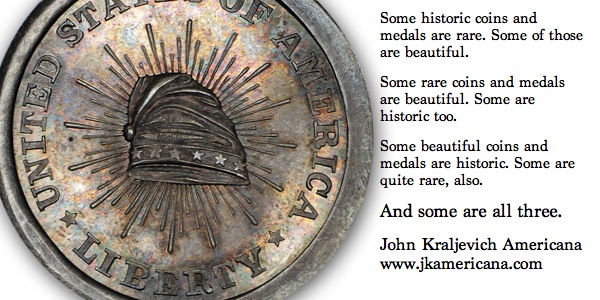
CENTRAL STATES AUTHOR GRANTS
Central States Numismatic Society Education Director Ray Lockwood writes:
Just for the record, Paul Cunningham received a grant from Central States to help him complete his book on Lincoln medals. We have helped thirteen writers publish books since we began our Author Grant project in 2011. Ten additional authors are currently working to complete books. We are very pleased that Central States has been able to contribute to numismatic literature in a meaningful way.
Ray adds:
To date, twenty authors have received grants up to $5,000, the maximum grant approval limit. Thirteen of these authors have produced books while the other seven are in various stages of research and publication. The grants do not carry mandatory completion dates. In fact, the grants may be utilized for research alone. The books that have been published to date and their authors include:
- Ron Abler – “A Centennial Cabinet: Exonumia of the 1876 U.S. Centennial”
- Jon Amato – “The Draped Bust Half Dollars of 1796 & 1797”
- Roger Burdette – “Various Numismatic Articles in the Journal of Numismatic Research
- Paul Cunningham - “Abraham Lincoln’s Metallic Imagery”
- Mark Ferguson - “The Dollar of 1804 – The U.S. Mint’s Hidden Secret”
- Kathy Freeland - “American Red Cross in WW II” (exonumia catalogue)
- Peter Huntoon – “Numismatic Articles on U.S. Date Back National Banknotes”
- Larry Lee - “Fort Atkinson & Western Frontier Numismatic Archeology”
- Fred Reed - “Civil War Stamp Envelopes – The Issuers and Their Times”
- Neil Shafer – “A Catalog of Panic Scrip of 1893, 1907 & 1914”
- TAMS/Q. David Bowers – U.S. Shell Cards: 1867 – 1880”
- Michael VanDen Heuvel – “Square Coins of the World – 1900 – 2008”
- Harry Waterson – “The Medal of the Month Club”
We know of no other numismatic organization that is funding numismatic research and/or publications. Awarding monies to numismatic authors benefits everyone in our great hobby. There never can be enough numismatic literature.
For more information on the CSNS Author Grant program, see:
Central States Numismatic Publication Grants
(www.centralstates.info/grants.html)
To read the earlier E-Sylum article, see:
NEW BOOK: LINCOLN’S METALLIC IMAGERY
(www.coinbooks.org/esylum_v18n31a05.html)
QUERY: CHESS-PLAYING AMERICAN NUMISMATISTS SOUGHT
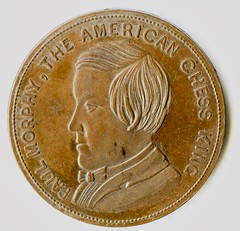
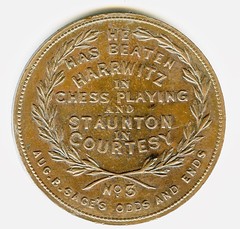
Dave Bowers writes:
Do you know of any American numismatists who were also accomplished in the field of chess? I have:
Ben Franklin, not a numismatist, but numismatically important for his coin legends and the printing of paper money;
Daniel W. Fiske, an assistant librarian at the Astor Library, NYC, in the late 1850s and an important numismatist,
Fred Reinfeld (1910-1960), a popular writer on chess (mostly) and coins, and
S.W. Brown, a Shreveport rare dealer in the 1980s who was also a regional chess champion.
This is for a chapter in a book I am doing, about Sage and his Paul Morphy token.
Dave adds:
The personal preferences and habits of historical, numismatic, and other people are seldom recorded. For example, while we know of some White House pets (Fala the dog, Socks the cat), we have no clue as to the type of toothpaste, beer, shoes, etc., that presidents preferred.
Many numismatists over the years have enjoyed and have even become prominent in non-numismatic activities and hobbies, but such are little recorded. One dealer was an avid big-game hunter, another a race car driver, another an important collector of stamps, etc., and so it goes.
Pete Smith writes:
John Dale Beety was a junior chess champion. I believe my American Numismatic Biographies is one of few sources that mention other interests of numismatists.
PETE SMITH ON DECODING THE SLAB
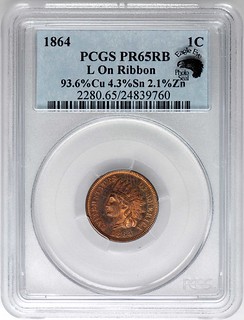 Last week The E-Sylum had a question about “Decoding the Slab” and the meaning of some terms used in coin descriptions. I told Wayne
I would see if there were other responses before I wrote. Apparently none of the other 1,852 E-Sylum subscribers can decode the
terms.
Last week The E-Sylum had a question about “Decoding the Slab” and the meaning of some terms used in coin descriptions. I told Wayne
I would see if there were other responses before I wrote. Apparently none of the other 1,852 E-Sylum subscribers can decode the
terms.
Let’s start with an overview of the third-party grading (TPG) system. There was a time when there were two types of collectors. The first type would say, “I like it, I’ll buy it.” The other type would say, “I think I like it but I want somebody to tell me what it is worth before I decide.” This created a business opportunity for third-party grading (slabs).
Jump forward to the next generation of collectors. Now they would say, “I know what it says on the slab but I want somebody to tell me if I can trust the slab.” This created another business opportunity. These efforts are mentioned on the slab. Rick Snow created Eagle Eye Photo Seal. The submission form says that for a fee of $15, “Your coins are looked at personally by Richard Snow. If they qualify for Photo Seal you can be assured that your coins are properly graded or premium quality for the grade indicated on the holder.”
 Then along came the Certified Acceptance Corporation (CAC). They apply an oval green sticker now known as a “green bean.” Their website
states that the CAC sticker means, “It has been verified as meeting our strict quality standards.” The third party graders have gone through many
generations of holder. One generation of PCGS holder had green labels. These are referred to as “original green holder” (OGH). Why is this
important?
Then along came the Certified Acceptance Corporation (CAC). They apply an oval green sticker now known as a “green bean.” Their website
states that the CAC sticker means, “It has been verified as meeting our strict quality standards.” The third party graders have gone through many
generations of holder. One generation of PCGS holder had green labels. These are referred to as “original green holder” (OGH). Why is this
important?
 There is the perception that grading was more conservative during the OGH era. Some dealers (crack-out artists) made their living buying up
OGH slabs to resubmit them for higher grades. So, an OGH slab may be a candidate for upgrading and increased perceived value. On the other hand, if
the coin is still in an OGH slab, no previous customer has thought it was worthy of a resubmission.
There is the perception that grading was more conservative during the OGH era. Some dealers (crack-out artists) made their living buying up
OGH slabs to resubmit them for higher grades. So, an OGH slab may be a candidate for upgrading and increased perceived value. On the other hand, if
the coin is still in an OGH slab, no previous customer has thought it was worthy of a resubmission.
Uncirculated copper coins show a continuum of color from red to brown. The grading services have determined that all copper coins are either red (RD), red and brown (RB), or brown (BN). The holder in question was called RB by PCGS but RD by the cataloguer.
Are there other codes found on slabs? I will leave those for the other 1,852 E-Sylum readers to explain.
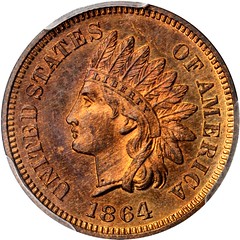

To read the complete lot descriptions, see:
Extremely Rare Proof-65 RB
1864 L on Ribbon Cent (www.stacksbowers.com/BrowseAuctions/LotDetail/tabid/
227/Lot/10035/AuctionID/6104/Default.aspx)
1807/6 Draped Bust Cent.
S-273. Rarity-1. Large 7, Pointed 1. (www.stacksbowers.com/BrowseAuctions/LotDetail/tabid/227/
AuctionID/6104/Lot/10028/Default.aspx)
To read the earlier E-Sylum article, see:
NOTES FROM E-SYLUM READERS: AUGUST 2, 2015 : Decoding the Slab
(www.coinbooks.org/esylum_v18n31a11.html)
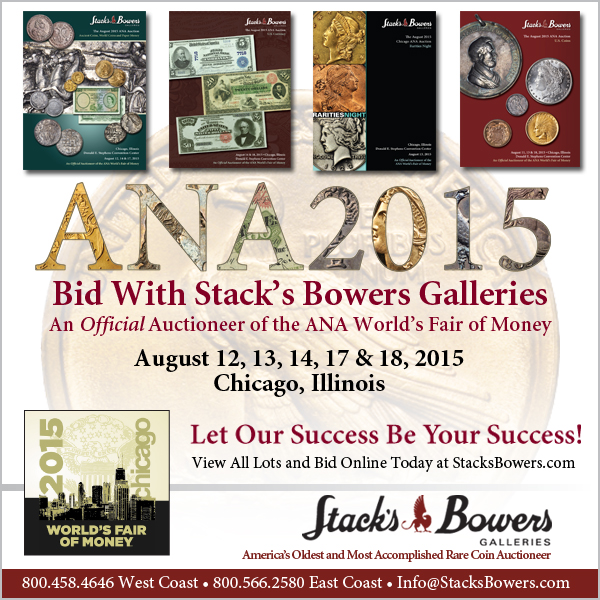
MORE ON ENGRAVER EMIL SIGEL AND HIS BROTHER FRANZ
Scott Miller writes:
Regarding Donald Erlenkotter’s comments about Emil Sigel’s relationship to General Franz Sigel, I did not discuss the matter in my recent book “Medallic Art of the American Numismatic Society”. While I was certainly aware of their kinship, I did not think it added much to untangling the muddled history of the Lincoln Memorial medal. I am, however, quite pleased that the record has been set to right.
David T. Alexander writes:
Thanks to Donald Erlenkotter for clarifying the relationship of General Franz Sigel and engraver Emil. Thanks to the decay in teaching American history, the general is largely forgotten today but when my late mother was in school (ca. 1908-1914) kids were given deep knowledge of the Civil War. She delighted in remembering meeting Civil War veterans, with the anecdote of an elderly German-American entering a Weinstube in Brooklyn, introducing himself to a fellow bearded veteran who exclaimed, "You fight mit SIGEL??II Zwei glas Bier!!!"
There is still a Franz Sigel monument in New York City that was nearly demolished in the Great Depression by NYC sculptors assured its restoration instead. It is said that nativists on the Union side objected to President Abraham Lincoln's promotion of "ethnic" officers for what they deemed political reasons but Sigel was a wonderful choice. Incidentally, in Sidney, Ohio, home of "Coin World" there is a monument inscribed ZUM ANDECKEN AN DEN DEUTSCH-AMERIKANISCHE FREIWILLIGEN, In Memory of the German American Volunteers of Western Ohio who fought in the War.
To read the earlier E-Sylum article, see:
ENGRAVER EMIL SIGEL AND HIS BROTHER FRANZ
(www.coinbooks.org/esylum_v18n31a10.html)
BENJAMIN T. WALTON AND RARE GOLD COINS
John Lupia writes:
Since we've been discussing U. S. gold in the 1880's our readers might find these two postal cards of interest sent to the Chapman Brothers by Benjamin T. Walton the Cashier of the Ninth National Bank, Philadelphia, who also was a part time coin dealer. Both postal cards mention very low mintage gold pieces.
The first one is an 1875 brilliant proof $3 gold piece for sale with an inquiry about its current market price. The owner has his value on the piece from $30 to $35. Walton is wondering if that value is supportable in any survey of sale records. With its U. S. Mint record of 20 pieces struck it was understood as having a premium of at least ten times face value eleven years after mintage.
In the second postal card another U. S. gold coin is mentioned, this time the 1796 quarter eagle. Walton wonders which one the Chapman Brothers are offering him -- with stars (432 minted) or without stars (963 minted).
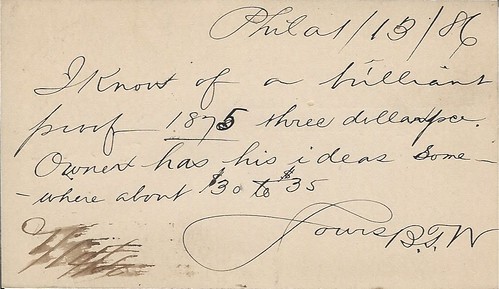
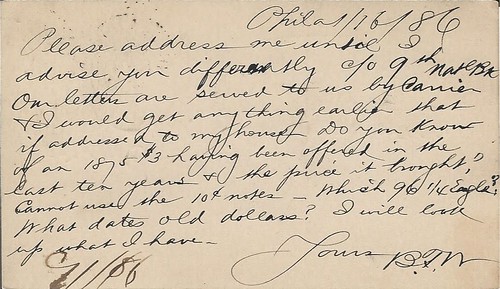
Benjamin T. Walton (1852-1914), was born on February 7, 1852 at Philadelphia, son of Benjamin T. Walton an immigrant from England and his wife Alice T. Boyer a native of Philadelphia. In the 1880 U. S. Census he is listed as a clerk living at 1109 Marlborough Street, Philadelphia with his wife Josephine E. Day (1848-1925), their two sons and his sister Eliza, a schoolteacher. He worked as the Cashier of the Ninth National Bank, Philadelphia from 1886 to 1914. He was also a part-time coin dealer and corresponded with the Chapman Brothers to buy and sell numismatic material. In 1886 he had one of the twenty 1875 Brilliant Proof $3 Gold pieces to sell the Chapman Brothers.
To read the complete article, see:
WALTON,
BENJAMIN T. (https://sites.google.com/site/numismaticmallcom/encyclopedic-dictionary-of-numismatic-biographies/walton-benjamin-t)
To read the earlier E-Sylum article, see:
H. C. KENDRICK OF BOSTON: NO DEMAND FOR GOLD DOLLARS
(www.coinbooks.org/esylum_v18n30a13.html)
THE BOOK BAZARRE
HOLABIRD WESTERN AMERICANA AUCTION SEPTEMBER 2015
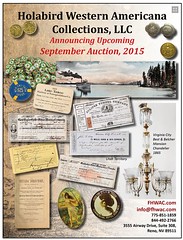 Holabird Western Americana Collections, LLC has an auction Sept. 24 to Sept. 27 that includes 58 national bank notes issued in Nevada,
including 18 rare large size notes.
Holabird Western Americana Collections, LLC has an auction Sept. 24 to Sept. 27 that includes 58 national bank notes issued in Nevada,
including 18 rare large size notes.
Peter Huntoon, who has written about currency for more than four decades and was one of the authors of the 1973 book “The National Bank Note Issues of 1929-1935,” said Nevada national bank notes are rare because there were relatively few banks and most of those banks were small. Nevada had only 16 issuing banks, for instance, while California had 509.
“That’s one of the scarcest states in the country,” Huntoon said. “Alaska is the only state smaller with three.”
Auctioneer Fred Holabird called the Nevada notes raw and said only one of the 58 national bank notes has been professionally graded. He described them as being from an old Nevada collection.

The single most valuable appears to be a large, uncirculated $10 note from Nevada’s McGill National Bank. Holabird said it may be unique. “It might be worth $50,000 today. The bidders will tell us.” Holabird said.
When the McGill bank closed in 1934 there was only $1,210 in national bank notes outstanding, Holabird said. “They got almost all of it back,” he explained.
In small notes the auction also includes one $10 note and two $20 notes from the McGill bank, all Type 1 with low serial numbers.
There is a large $10 First National Bank of Winnemucca note Holabird described as a gem. There are also two large $50 notes. For small notes, there are two $5, two $10 and a $20, all type 1. The bank had $9,855 outstanding in notes when it closed in 1935.
The First National Bank of Winnemucca was reportedly robbed by Butch Cassidy but that was never proven, Holabird said.
For the First National Bank of Ely there is one $5 in a large note, two $10 and one $20. Holabird said the $10 notes have different signatories. Ely and neighboring McGill were one of America’s largest copper mining camps that produced about $400 million in metals before World War II.
For small notes, there is one $5 and two $20, all type 1, from the First National Bank of Ely. For the Ely National Bank, there are two $20, both type 1, and two $10 notes, a type 1 and type 2. First National Bank of Ely had $49,000 outstanding in notes in 1935 and Ely National Bank had $43,050 outstanding.
In large notes for the Reno Farmers and Merchants Bank, there is a $10 and a $20. For the Reno National Bank there are three $50 and a $100, some signed by Nevada mining financier and historical figure George Wingfield.
In smaller notes, there is a First National Bank of Reno $10 type 2 note, PCGS 64, high grade and uncirculated, Holabird said. For Reno National Bank, there are four $50 notes, including low serial numbers, and a type 1 $100 with serial number 6, probably owned by one of the bank’s original officers.
In the last of the large notes, there are three $10 First National Bank of Elko notes, all with different signatures, and two $20, also with different signatures. In smaller notes, there are $5 and $10 notes, and Elko had $2,180 out in small notes and $6,262 in large size when it closed in 1932.
In smaller notes, for the Farmers and Merchants National Bank of Eureka, there are two $10 notes, one type 1 and one type 2, and three $20, all type 1, all with low serial numbers. Eureka was a silver mining camp, producing about $65 million before World War II.
For Lovelock there were two $10, one type 1 and one type 2, and a type 1 $20. Lovelock was the commercial center for mines in the mountains north of town that included Seven Troughs and Mazuma.
For the First National Bank of Tonopah, there was one $10 and one $20, both type 1. Tonopah was another major Nevada mining camp with about $150 million in gold and silver production before World War II.
So many large denomination notes are unusual, Holabird noted. “They’ll keep a $5 note as a collectible before they ever keep a $100 note,” Holabird said. “They’re going to cash that $100 in quick.”
The low estimate for the sale is $1 million to $2 million, Holabird said. Other items being auctioned include:
- One of the best collections ever assembled of western Mechanics Fair and Agricultural Medals, highlighted by a Gold Mechanics Institute medal for replica of a steamship.
- California fractional gold pieces. About 100 from several collections, including some rarities. These are very small pieces with a face value of 25 cents, 50 cents and a dollar.
- More than 100 other numismatic collectables, including American coin rarities set in sterling silver made by San Francisco silversmith George Schreve, including a rare 1891 Carson City dollar set into a small tray.
- Large selection of facsimile currency and advertising notes.
- A major selection of Montana tokens from the Bob Svoboda collection that Holabird Americana is selling over a year.
The sale features the strongest and largest section of numismatic collectibles seen in memory – hundreds of lots. A few of the categories:
- George Schreve, San Francisco silversmith, made coin – in – silver items. He often used rare or scarce coins such as CC Dollars. The sale has more than ten Schreve pieces.
- South American Coin art. About a dozen pieces of Peruvian-Bolivian design from the 1870’s-80’s of tribal art on native cloth. Pieces contain as many as hundreds of “Spanish” and SA silver pieces.
- Coin bracelets and jewelry. A number of unique pieces, showing off the beauty of coin design
- Coin dispensing machines from the 1800’s to early 1900’s. Staats and other brands that include gold coin troughs
- Banks. Toy banks, many from the West.
- Real Coin art, from pop-ups to encasements, circa 1880-1910
- Love tokens
- Glass coin art
- Original photographs (and postcards) of various Mints and money, c 1860-1910
For more information on the sale, see:
http://holabirdamericana.com/
HARVEY STACK ON THE PRINTED WORD IN NUMISMATICS
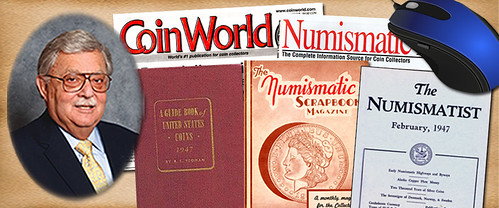
A few weeks ago I started writing about some comments made by David Harper of Numismatic News at the Texas Numismatic Association Show in early June regarding the demise of the printed word in numismatics.
When I consider the next 25 years, I agree with many of Dave Harper's predictions, but I will offer some ideas that I think are important to maintain collector interest and keep the hobby viable and exciting
As I noted earlier, David Harper’s remarks about the demise of the printed word gave me much to think about. Obviously, the main factor that has caused the printed word to lose favor among coin collectors (as well as other hobbies) is the fast, current information provided by the Internet -- definitely a positive aspect in many regards. However, I hope that David Harper is incorrect when he says that the printed word will be completely supplanted by electronic media.
The current world is demanding, requiring immediate news and speedy answers to any questions. In this way electronic media has an edge on the printed word. But do we always need to be informed so quickly? I think not! Sometimes great enjoyment comes from studying, reviewing and finding the answers to questions, not necessarily just having the information immediately provided.
Many of the great collectors I have known were not in a rush to complete their cabinets. The fine collections I have helped start, build, improve and eventually sell were not accumulated in a hurry. Louis E. Eliasberg spent many years building his monumental collection and continued to collect until he passed away in 1976. He enjoyed owning and displaying the collection. Josiah K. Lilly, whose collection is one of the feature collections housed in the Smithsonian Institution, started collecting in 1951 and the coins were given to the Smithsonian only after his death in 1967. Even the D. Brent Pogue Collection that Stack’s Bowers Galleries is auctioning now in the 21st century, was carefully and diligently collected over 40 years. Devoting time to building a fine collection is an essential part of the process.
I have heard this phrase said often and like to repeat it to myself: "A collection [of anything, in this case coins] is not a necessity of life, you do not have to wear it, eat it or live in it,” so there is no reason to rush.
The electronic world has changed the way things are happening, but I still feel it is not the only tool needed to be a collector. Perspective can be gained by reviewing the past and comparing it to the present. While more and more information is available on the Internet (if one knows how and where to look), there is much that is not. Actual printed documents offer readers the ease of reviewing and making notes. I find that information found on the Internet is often printed out, thus becoming the “printed word.”
And, there is something special about a book or magazine that you can hold in your hand. Reading books, auction catalogs and pricelists in a quiet relaxed setting can be a pleasurable experience as well as a way to get information. Even the pdf catalogs available at StacksBowers.com speak to the desire of our customers to view auction lots in the context of the other coins in a sale.
The content of books is surely not all reproduced electronically, even though more and more is available as each day passes. I congratulate the ESYLUM, published by the Numismatic Bibliomania Society, for its efforts to electronically provide listings of reference books and contents for collectors in the future who are unable to find the information desired. But, it will take a long time, if ever, before everything is available on line.
Maybe in the future there will be no need for the printed word. But until that time, enjoy the printed auction catalogs produced by the major auction companies, read the books published by the Whitman Publishing Company, read articles in The Numismatist and other weekly and monthly publications, as well as those put out by various specialized numismatic societies. When you can, attend a lecture or presentation by an accomplished author and researcher. I believe that all of these are worthwhile tools for numismatists, just as electronic information is a useful tool. Numismatic toolboxes can include many things, all of which combine to increase your enjoyment of our great hobby.
The electronic world is here to stay, but I hope that David Harper’s predictions do not come true. It is my wish that printed publications will continue to be produced and enjoyed well beyond the next quarter of a century.
Harvey adds:
I have always felt, maybe because I am old and depend on my own habits that have ruled me, there is something personal about reading printed copy and being able to have it in front of you, and using the information as it is needed.
A printed word has great longevity and handiness that is not easily studied on the internet. The internet is great as a POINTER to where something can be found, but if you needed something as simple as a number of pieces struck in one year, you would have to take a search engine to help you find it , when you could readily pick up a Guide Book to find the information by just turning a few pages.
Yup, I am old fashioned, not fully trained in internet devices and methodology, but I am a happy Numismatist, and feel that the Printed Word has more efficiency at times then the electronic world.
To read the complete articles, see:
The Demise of the Printed World in Numismatics, Part Three (www.stacksbowers.com/NewsMedia/Blogs/TabId/780/ArtMID/
2678/ArticleID/65279/The-Demise-of-the-Printed-World
-in-Numismatics-Part-Three.aspx)
The Demise of the Printed Word in Numismatics, Part Four (www.stacksbowers.com/NewsMedia/Blogs/TabId/780/ArtMID/
2678/ArticleID/65291/The-Demise-of-the-Printed-Word
-in-Numismatics-Part-Four.aspx)
To read the earlier E-Sylum article, see:
HARVEY STACK ON THE PRINTED WORD IN NUMISMATICS
(www.coinbooks.org/esylum_v18n28a40.html)
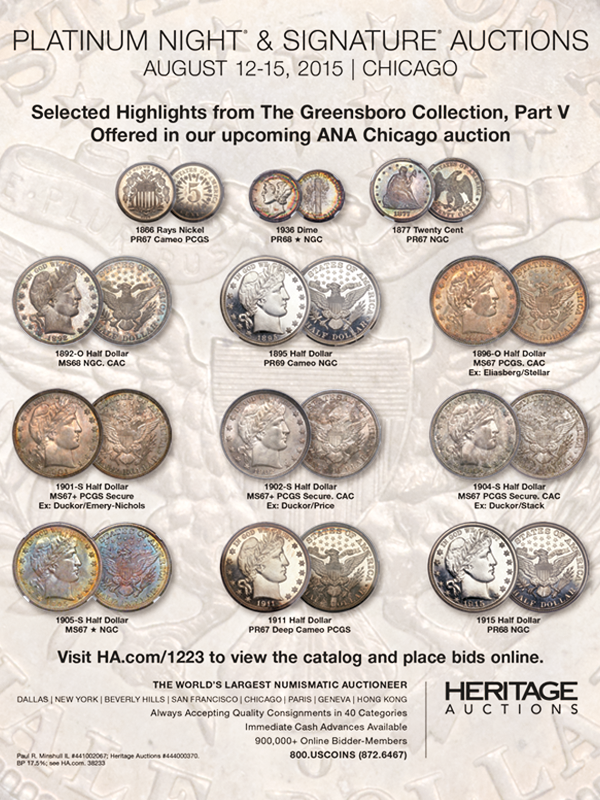
LEOMINSTER ROMAN COIN HOARD FOUND
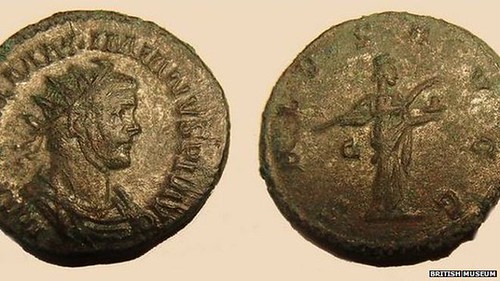
A hoard of more than 500 Roman coins was found by two metal detector enthusiasts in a Herefordshire field, the British Museum has revealed.
The 518 mixed copper coins, found near Leominster, had been placed in cloth bags and hidden in the ground in a leather satchel.
Experts believe the coins were deliberately buried because of unrest or fear of robbery.
The British Museum said it was very rare to find hoards so well-preserved.
The hoard was found in July 2013 by paramedics and metal detector enthusiasts Jeremy Daw and Martin Fulloway.
Mr Fulloway said four of the coins were stuck to a stone, while others were in the loose soil.
"It's not quite the Staffordshire hoard but for Herefordshire it's nice. For me to have my first Roman hoard, it's a dream come true."
Mr Daw said the coins were possibly buried during a time of unrest in the Roman empire.
"It's been in the ground for 1,700 years and we are the first people to touch it," he said.
"We looked at each other and punched the air."
The earth was x-rayed at Birmingham Museum and Art Gallery and then examined by the British Museum.
The coins range from AD 260 to circa 290 and include eight coins of the Britannic Empire.
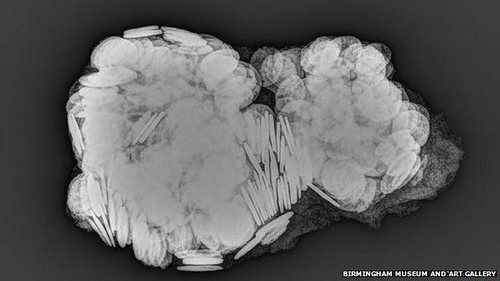
X-Ray Image
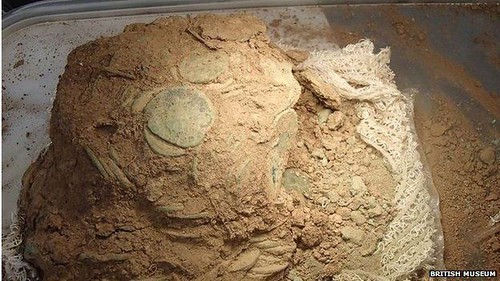
To read the complete article, see:
Leominster Roman coin hoard found by Herefordshire metal detector
pair (www.bbc.com/news/uk-england-hereford-worcester-33815609)
RARE SOLIDUS OF EMPEROR HONORIUS OFFERED
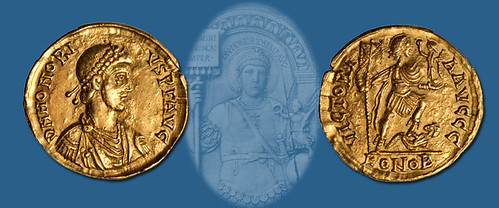
The official Stack’s Bowers Galleries auction for the ANA World’s Fair of Money is nearly here, and we have a final ancient coin to preview -- a historically significant piece and a terrific rarity. This piece is deserving of a word not often thrown around in numismatics: unique. The Solidus described here is truly one of a kind. This coin was produced in the Arles Mint (southern France) during the reign of the Western Roman Emperor Honorius. During a period of substantial decline, Honorius managed to exacerbate the erosion of Roman power and influence. Widely considered an unfit ruler, he was thrust into power at a young age and as such relied heavily on his principal general, Stilicho. After Stilicho’s execution by a power-hungry minister, the army formerly under Stilicho’s control defected en-masse to the Visigoth horde preparing to invade Italy. Led by their king Alaric, the Visigoths laid siege to Rome.
Honorius, now lacking an able general to marshal the culturally diverse Roman armies, believed he could wait passively for the Visigoths to tire themselves outside the gates of Rome while his reinforcements arrived from distant provinces. Unfortunately, the starvation inflicted on the Roman populace coerced them to open the gates to Alaric. This event marked the first time Rome was under the control of an invading foreign force since an invasion of Gauls over eight centuries earlier. Thankfully the damage to the city was mild, although the psychological blow to Roman power was substantial.
The coin features a pearl-diademed, draped and cuirassed bust of Honorius facing right, with the legend: “D N HONORI – VS” around. The reverse shows a triumphant Honorius in military attire, in his left hand he holds a globe, surmounted by the deity Victory. In his right hand, he holds a labarum while his left foot pins down a bound captive. Some scratches are present though overall this singular example retains a wholesome and attractive nature.
To read the complete article, see:
Unique and Historically Significant Honorius Solidus Featured as lot #30102 in the Stack’s Bowers Galleries 2015 Chicago ANA
(www.stacksbowers.com/NewsMedia/Blogs/TabId/780/ArtMID/
2678/ArticleID/65293/Unique-and-Historically-Significant-Honorius-Solidus
-Featured-as-lot-30102-in-the-Stack%E2%80%99s-Bowers-Galleries
BEST. ROYAL. NICKNAME. EVER.
Many members of royalty in history have had nicknames associated with them. Some of them are descriptive: Ivan the Terrible, Richard the Lion Hearted, Catherine the Great, etc. But my favorite is Leopold the Hogmouth. This is mostly because it is such a colorful nickname, but it is also directly related to numismatics. Leopold I (name in full: Leopold Ignaz Joseph Balthasar Felician; Hungarian: I. Lipót; 9 June 1640 – 5 May 1705) was Holy Roman Emperor, King of Hungary and Croatia and King of Bohemia. Leopold I reigned as Holy Roman Emperor from 1657 until his death in 1705.
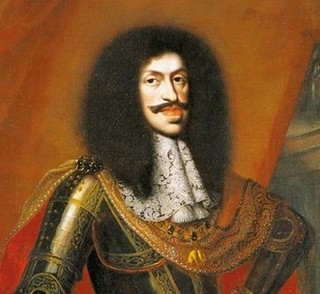 What history remembers Leopold for, however, is a condition known scientifically as mandibular prognathism—a genetic defect in which the
lower half of the jaw is longer than the upper, known colloquially as the Habsburg jaw. The royal lines of Europe were famously inbred, and Leopold’s
line was no exception. First cousins married first cousins, who then married other first cousins, and recessive genetic defects exploded. The
egregiously inbred Charles VII of Spain, born with webbed feet and several other physical and mental disabilities, was Leopold’s nephew. Looking at a
painted portrait of Leopold gives a hint of his Hapsburg jaw.
What history remembers Leopold for, however, is a condition known scientifically as mandibular prognathism—a genetic defect in which the
lower half of the jaw is longer than the upper, known colloquially as the Habsburg jaw. The royal lines of Europe were famously inbred, and Leopold’s
line was no exception. First cousins married first cousins, who then married other first cousins, and recessive genetic defects exploded. The
egregiously inbred Charles VII of Spain, born with webbed feet and several other physical and mental disabilities, was Leopold’s nephew. Looking at a
painted portrait of Leopold gives a hint of his Hapsburg jaw.
One can see how he could be given his nickname. Given the propensity of artists to paint flattering portrayals of their patrons, however, makes one wonder how accurate this depiction is. Ironically, a portrait of Leopold that is more exaggerated is the one that many more people would see: his effigy on the coins during his reign.
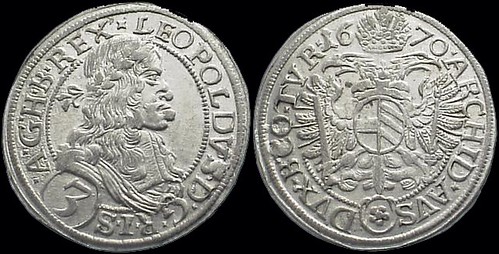
This silver coin, a 3 kreuzer piece from 1770, gives an almost cartoonish portrait, and is said to not accurately reflect his actual profile. While no one would accuse the Emperor of being a handsome man, Leopold was less deformed than the unflattering portrait he chose to display on his coinage. Indeed, it is widely believed that it was this coin that gave rise to the “Hogmouth” sobriquet. I suppose being Holy Roman Emperor gives one the self-confidence not to care what he looks like on his coins.
AN EARLY EMBOSSED NUMISMATIC ILLUSTRATION
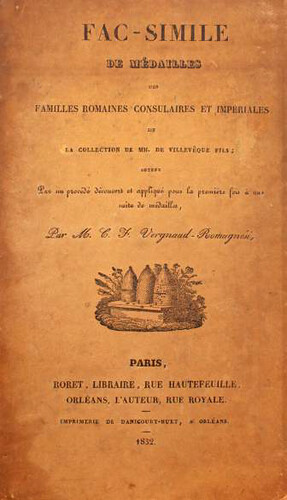
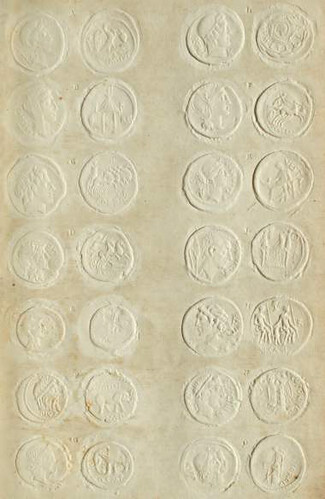
Vergnaud-Romagnési, M. C. F. Fac-Simile de Médailles des Familles Romaines Consulaires et Impériales de la Collection de Mm. de Villevêque Fils; Obtenu Par un Procedé Découvert et Appliqué Pour la Premiere Fois à une Suite de Médailles. Paris, Roret, Libraire, Rue Hautefeuille Orleans, L’Auteur, Rue Royale, 1832. Octavo, pp. iv, 18 pages of plates depicting the embossed impressions of between 6 and 14 coins all on paper, with original tissue guard and an accompanying page of descriptive text. In the original printed boards, with a charming vignette on the upper cover. Original paper label to spine. From the libraries of Pierre Lambert and Ferdinando Bassoli and with their neat ex-libris on the front paste-down. Joints cracked and weak but still intact, boards a little discoloured. Contents clean with only minimal browning. A fine copy of an exceptionally rare and fascinating book. £2,650
Charles François Vergnaud-Romagnési (1785-1871) was a successful merchant, a member of a variety of historical and academic societies including the Society of Antiquaries of France and author of a number of books, most notably perhaps his history of the city of Orleans (1830). The present title is very rare and unrecorded in all the usual bibliographies with the only institutional copy found at the Bibliothèque Nationale.
It is very possibly one of the earliest examples of embossed numismatic illustration and is contemporaneous with Sir Edward Thomason’s ‘Enammelled Impressions struck off from the Splendid Series of Medal Dies’ (See Manville Vol. 3, 293) which was published (albeit without imprint) c. 1830-1840.
The embossed images on the plates are simple yet effective, having been spared the somewhat gauche treatment of later embossed plates with metallic tints which have a tendency to look clumsy. 224 Roman coins are depicted, starting with Roman Republican issues, through to the Imperatorial and Imperial issues and right down to the reign of Julian II, the Apostate.
The seventeenth plate depicts three Roman medallions but is interesting more for the explanation written in the Avertissement rather than the coins themselves, ‘Le XVIIe planche contient trois médallions de trois degrès différens de conservation. Le premiere, Antinoüs, est le mieux conservé; celui du dessous, de Lucius-Verus, l’est moins bien; et enfin le dernier, celui de Néron, l’est encore plus mal.’ Although not the purpose of the book itself, it would appear that this plate is very probably the earliest visual example of coin grading, something which would not have been possible with engraved or lithographic illustrations which were notoriously inaccurate.
The quality of these embossed images both in terms of their relief and accuracy, is remarkable, the method of production being achieved by direct impression with the coins rather than casts or sulphur impressions. The final two plates, the latter of which is unmentioned in the text, illustrate historical medals of Orleans. (For more information on embossed illustrations in numismatic books see also George Frederick Kolbe Auction 112, 13th May 2010).
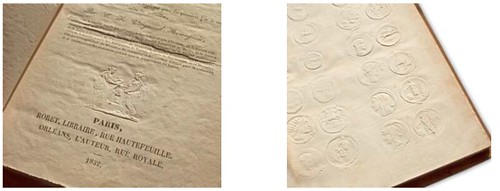
To read the complete fixed price list, see:
http://baldwin.us6.list-manage.com/track/click?u=7d9a0f4e5824469c13ef30d0d&id=d891a29531&e=e55a5f6abf
THE BOOK BAZARRE
THE IRISH LADY LAVERY BANKNOTES OF 1928-1977

World paper money is an area of numismatics that has seen a substantial increase in interest over the last couple of years. With a rich history going back to the 14th century, this should not come as a surprise. Paper money collectors have a wide variety of possibilities available to them, and their collections can be organized by country, theme, and even material. In this article, we will take a look at one long-running series of paper money that is popular with collectors worldwide: the Irish Lady Lavery, or “Series A” Legal Tender Notes of 1928 to 1977.
Following the establishment of the Irish Free State in 1922 and the enactment of the Currency Act in 1927, Lady Lavery banknotes were issued in a total of seven denominations; each had a slightly different design containing either a head portrait (10 Shillings, 1 Pound, and 5 Pound) or a half-length portrait (10 Pounds, 20 Pounds, 50 Pounds, and 100 Pounds) of Lady Hazel Lavery.
Born in Chicago on March 14, 1880 as Hazel Martyn, Lady Lavery was the second wife of portrait artist Sir John Lavery. John Lavery designed this long-running series of banknotes using the portrait of his wife as an allegorical representation of Ireland.
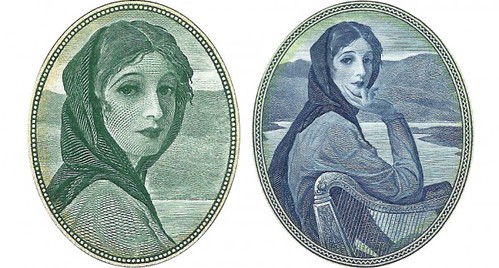
The back of the Lady Lavery banknotes feature designs that at first glance may appear identical, but are not. Centered in an ornamental design is a so-called River Mask, which can be found on the façade of the Dublin Custom House. The masks represent various rivers in Ireland, and were designed by the sculptor Edward Smythe. Initially the notes were printed by the London firm of Waterlow & Sons; later they were printed by Thomas De La Rue.
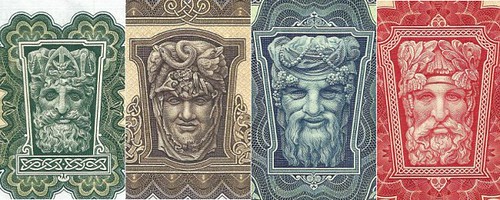
The notes were introduced by the Currency Commission of the Irish Free State on September 10, 1928, which is the first date for all denominations. From 1938 to 1943, the notes were issued by the Currency Commission of Ireland, after which the newly created Central Bank of Ireland took control of their production.
Initially, the notes circulated alongside so-called consolidated banknotes, which were issued by commercial banks throughout Ireland under the auspices of the Currency Commission. These consolidated banknotes (also called Ploughman Notes) were withdrawn from circulation starting in 1953, when the Lady Lavery Banknotes became the only circulating banknotes in Ireland.
To read the complete article, see:
The Irish Lady Lavery Banknotes of 1928-1977
(http://news.coinupdate.com/the-irish-lady-lavery-banknotes-of-1928-1977/)
ALTERNATIVE CURRENCIES: ARTISANAL CASH
Though paper money here typically bears the visage of Queen Elizabeth, the Brixton district of the city last month released a new 5-pound note designed by Jeremy Deller, an artist who won the prestigious Turner Prize in 2004. It features a fuzzy, psychedelic image of an androgynous face surrounded by rainbow clouds and coruscating, swirling etchings.
“I wanted something old-fashioned looking,” Mr. Deller said. “Something almost pre-currency.”
One hundred and twenty miles west of Brixton, in the city of Bristol, a pound note issued after a design competition that was open to locals displays a colorful lemur striding atop a vibrant cityscape. The back has magenta-hued, hand-cut stencil illustrations of accomplished denizens, including the author J. K. Rowling and Dr. Elizabeth Blackwell, the first woman to receive a medical degree in the United States.
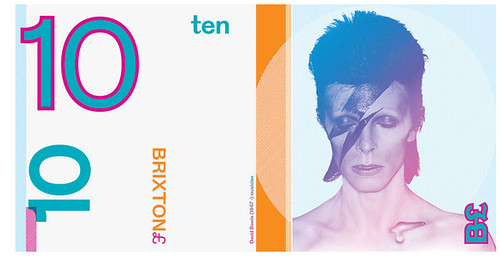
£10 Brixton note honors David Bowie
Many of the new alternative currencies have the look and feel of the regular legal tender accepted at such places. Most include anticounterfeiting measures like holograms and serial numbers. But they are more eye-catching.
At the Effra Social, a Brixton pub, Ewan Graham, 31, an architect, was impressed upon examining one of the district’s special pound notes for the first time. “I’d be more inclined to save money if it all looked like that,” he said.
The back of the note displayed a Karl Marx quote about capital and its “occult ability to add value to itself.” The £10 note, meanwhile, pictured David Bowie, a Brixton native (stardust, or other powdery substance, not included). It’s easy to imagine such notes being fetishized as audiophiles do vinyl.
The local currency, though, is intended not as collectible but to encourage trade at the community businesses where they are accepted, rather than chain stores, where money taken in tends to flow out of town and into the coffers of multinational corporations.
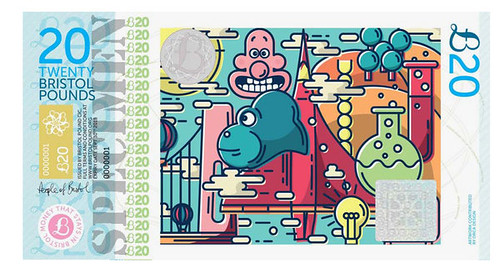
£20 note from Bristol
One perhaps surprising alternative-currency enthusiast is the former central banker Bernard Lietaer, who was an architect of the European Currency Unit, the convergence system between 12 currencies that led to the euro. Now a professor of money and sustainability at the Sorbonne in Paris, he believes that money is “an extraordinarily emotional object,” the immense power of which he likens, psychologically, to sex. Alternative currencies, he suggested, provide an “implicit incentive: I want to give priority to — and I’m willing to make an effort for — my region or community.”
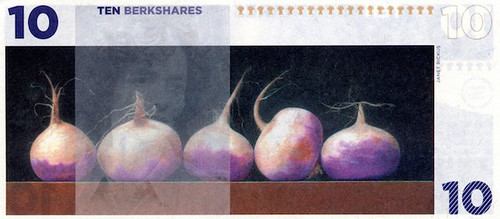
BerkShare currency used in Great Barrington, Mass.
To read the complete article, see:
Do You Have Change for a Bowie?
The Advent of Artisanal Cash (www.nytimes.com/2015/08/09/fashion/change-for-a-bowie-the-advent-of-artisanal-cash.html)
To read the earlier E-Sylum article, see:
NEW BRIXTON POUND DESIGN BY JEREMY DELLER
(www.coinbooks.org/esylum_v18n31a25.html)
MEDAL TO COMMEMORATE POPE FRANCIS' VISIT TO AMERICA
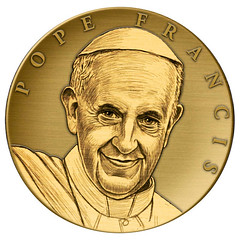
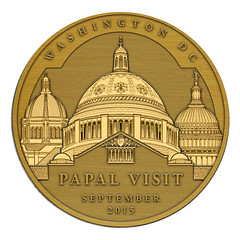
The Pennsylvania Association of Numismatists will have medals commemorating the September visit of Pope Francis to America available for sale at the American Numismatic Association World’s Fair of Money August 11 – 15 at PAN table 1957. PAN President, Tom Uram presented the idea to Archbishop Donald Cardinal Wuerl of the Roman Catholic Archdiocese of Washington at a meeting on January 28th 2015.
Cardinal Wuerl and Tom Uram agreed that such a wonderful idea should be done with a high level of quality and care. Tom immediately commissioned renowned sculptor and engraver Don Everhart to create the design work. The artwork was put forward as time became critical. To be able to reach a design agreement and allow enough time for Don Everhart to sculpt it and get it into production became a formidable challenge.
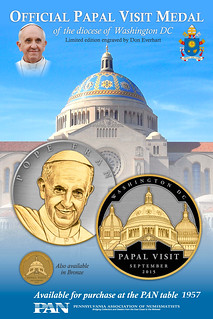 The essence of the medal focuses on the Pope’s visit to Washington D.C. on September 23rd, 2015. Don produced a beautiful image of Pope
Francis that captures his warmth and charm on the obverse and a reverse that features the three Washington D.C. iconic domes, the Basilica of the
National Shrine of the Immaculate Conception, the Cathedral of St. Matthew the Apostle, and the dome of the U.S. Capitol building.
The essence of the medal focuses on the Pope’s visit to Washington D.C. on September 23rd, 2015. Don produced a beautiful image of Pope
Francis that captures his warmth and charm on the obverse and a reverse that features the three Washington D.C. iconic domes, the Basilica of the
National Shrine of the Immaculate Conception, the Cathedral of St. Matthew the Apostle, and the dome of the U.S. Capitol building.
The medals were produced at the Northwest Territorial Mint and were just delivered to PAN on Friday, August 7th. The sizes and pricing are: 3” silver with black enamel and 24k gold embellishment at $450, 3” bronze with black enamel at $100, and 1.75” silver with gold embellishment at $150. The 3” medals are housed in a beautiful custom wood box that are back ordered and will ship later.
The medals will also be on sale through the PAN website at www.pancoins.org after the ANA show. The Basilica of the National Shrine gift shop will have a 1.75” bronze version with a single Basilica dome reverse available for sale.
1870 HALF DOLLAR CANCELLED OBVERSE DIE
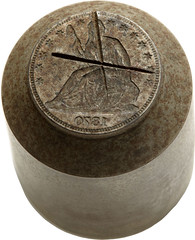
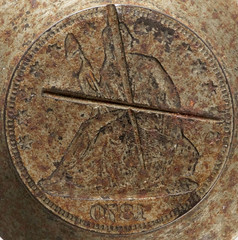
1870 Half Dollar Cancelled Obverse Die. The last time we handled a cancelled die from the Seated Liberty series was more than 10 years ago (an 1870-CC Seated dollar reverse die), and any appearance of a 19th century cancelled die is a rare numismatic event. Our research indicates fewer than a dozen such dies from the 1800s have appeared at auction over the years. To our knowledge, this is the only cancelled half dollar die from the watershed year of 1870 that is available to collectors regardless of Mint origin -- Philadelphia, San Francisco, or Carson City.
A burning question exists. Which Mint does the die belong to? The San Francisco Mint was ruled out as the source of the die because just two half dollar obverses are documented for the year, neither matching this die. A more likely source of the die would be the Carson City Mint - although any surviving half dollar die from 1870 would be extremely rare. Just three obverse dies are confirmed for the CC-Mint in that low-mintage year.
More fuel for the fire...a large hoard of cancelled dies was unearthed on the grounds of the Carson City Mint in 1999. As many as 500 obverse and reverse dies were discovered by contractor Dennis Cassinelli and a team of archaeologists from the Nevada State Museum. The dies were dated throughout the 1870s and included all denominations minted in Carson City from dimes to double eagles. Of these, the 1870-dated dies are among the most compelling, since it was the first year of production for the fabled Carson City facility.
About two years ago, noted Seated coinage experts Bill Bugert and John Dannreuther had the opportunity to examine this exact die. The die displays physical characteristics of the Carson City hoard. Considerable die rust (suggestive of possible burial), an X-shaped pair of cancellation strikes imparted by a chisel or similar tool, and a date position with full drapery similar to an obverse die known to have struck 1870-CC half dollars -- all of these characteristics are present and intriguing.
Other factors, however, lead Bugert and Dannreuther to conclude that this is an unused Philadelphia die. Lack of noticeable die clash in the drapery beneath Liberty's elbow suggests it cannot be the Carson City obverse closely matched by the date position. The possibility remains that the die is an unused "CC" obverse, since die shipment records are incomplete for Carson City in 1869 and 1870. However, there are no markings on the base or the cylinder of the die to indicate it was intended for the Carson City Mint (several of the recovered dies had either a C or CC stamped on the side).
If this indeed is an unused Philadelphia Mint die, it may represent an even greater rarity, since there have been no large hoards of cancelled Philadelphia dies from the 1870s. The die is a remarkable numismatic artifact that presents a rare opportunity for the specialist to add a seldom-offered Mint relic as the capstone for a fine Seated Liberty collection.
(Heritage thanks Bill Bugert and John Dannreuther for their contributions to this description.)
To read the complete CoinWeek article, see:
Unique
and Unusual Numismatic Items – 1870 Seated Half Dollar Obverse Cancelled Die
(www.coinweek.com/coins/unique-unusual/unique-and-unusual-numismatic-items-1870-seated-half-dollar-obverse-cancelled-die/)
To read the complete lot description, see:
1870 Half Dollar Cancelled Obverse Die.
(http://coins.ha.com/itm/seated-half-dollars/half-dollars/1870-half-dollar-cancelled-obverse-die/a/1223-4065.s?ic4=ListView-ShortDescription-071515)
TIMES ARTICLE FAVORS KEEPING HAMILTON

A new poll out on Wednesday shows that 27 percent of Americans would like to see Eleanor Roosevelt on the $10 bill and about 17 percent want Harriet Tubman. Sacagawea came in third with 13 percent and Susan B. Anthony and Amelia Earhart each had 11 percent.
Those are interesting findings, but there is a related question that is perhaps even more important: Do Americans want a woman on the $10 bill or the $20 bill?
The Treasury secretary, Jacob Lew, says he wants to put a woman on the $10 bill, which currently has a portrait of Alexander Hamilton, which is why the Marist Poll focused on the $10 bill. Mr. Lew has said it is up for a redesign for anti-counterfeiting purposes; he has also promised to keep Mr. Hamilton on the bill in some form – either somewhere else on the bill or by issuing two different versions of the note.
But, as the editorial board wrote in July, it would be far better for a woman to replace Andrew Jackson on the $20 bill. Jackson is one of the most controversial presidents in American history. He owned slaves and he was responsible for the destruction of American Indian tribes in the southeast. By contrast, Hamilton, the country’s first Treasury secretary, was an abolitionist and created the foundations of the American financial system.
Marist did not ask people whether a woman should go on the $10 or the $20. But in March, a Rasmussen Reports poll found that 45 percent of the people surveyed wanted a woman on the $20, 34 percent disagreed with that idea and 22 percent were undecided.
That was before Mr. Lew put out his $10 bill proposal. Lots of polls are being conducted these days for the 2016 presidential election. Maybe those pollsters could add a question to their voter surveys: Should a woman be on the $10 or the $20?
To read the complete article, see:
A Woman on the $10 or the $20 Bill?
(http://takingnote.blogs.nytimes.com/2015/08/05/a-woman-on-the-10-or-the-20-bill/)
It’s Eleanor for the 10-spot: The nation has spoken, at least in one survey. A McClatchy-Marist poll released Wednesday reveals that 27 percent of Americans favor Eleanor Roosevelt to be the portrait of choice when the U.S. Treasury Department unveils its redesigned ten dollar bill some five years in the future. The first lady was also favored by 34 percent of Democrats, 28 percent of Republicans and 26 percent of independents.
Harriet Tubman is the second most popular choice with 17 percent, followed by Sacagawea with 13 percent. Susan B. Anthony and Amelia Earhart each receives 11 percent, and Sandra Day O’Connor garners 4 percent.
To read the complete article, see:
Eleanor Roosevelt wins top
billing for the new $10 bill - but 11 percent can’t name anyone: Poll
(www.washingtontimes.com/news/2015/aug/5/eleanor-roosevelt-wins-top-billing-new-10-bill-pol/)
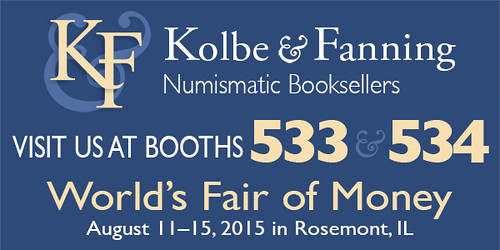
$1 BILL RETAINED OBSTRUCTION ERROR
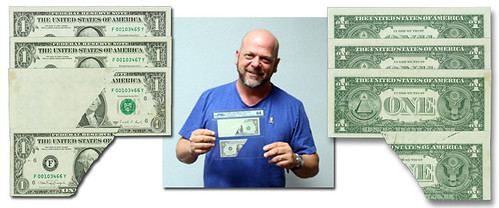
One lot in our Stack’s Bowers Galleries Official Currency Auction of the ANA World’s Fair of Money stands out not only for its wild appearance but also for the famous pedigree that accompanies it.
“At first look I thought this was a fake, it just seemed impossible.” That was Rick Harrison’s first impression of the incredible retained obstruction error $1 Federal Reserve Note offered as lot #40237 in next week’s auction. Harrison is the well-known owner of the Gold & Silver Pawn Shop in Las Vegas, Nevada, and the star of the History Channel’s hit reality series “Pawn Stars.” He consigned the incredible piece to Stack’s Bowers hoping that prospective bidders would be as wowed by incredible error as he was.
The seemingly impossible error is the most dramatic retained obstruction error we’ve ever seen -- a Fr. 1915-F Series 1988A $1 Federal Reserve Note with an approximately 50% obstruction of the face printing affecting the entire left side of the note as well as a diagonal portion up through the portrait at the center of the note. The obstructing item is what makes the error especially fantastic, as it is a fragment of a note, of corresponding size to the obstruction, and features all three stages of a print run. That’s right, the retained item which caused the obstruction on the face of the host note not only displays a face printing but also a printed back and overprint on the face.
While such an error is incredibly unlikely, seemingly impossible even, the circumstances of how it came to be can be explained. The obstructing fragment comes from a sheet prior to that of the host note. A misaligned first (back) printing on the fragment would indicate that a problem likely occurred when the sheet was fed into the printing press. Likely the misaligned sheet caused a jam when the sheet was flipped causing it to tear. Part of that torn sheet came back down onto the sheet of the host note which then went together through the second (face) and third (overprint) printings. They remained together for cutting and banding which allowed this astounding error to escape the production facility. It was eventually discovered and saved along with its corresponding bookend notes.
Notable error note specialist Frederick Bart confirmed the process which resulted in the error and described the obstruction piece as “one of the most exciting error discoveries of the decade.” Bart further pointed out that there is no equally impressive obstruction error to be found in his soon to be released 4th edition of United States Paper Money Errors.
To read the complete article, see:
Rick Harrison’s Wild Retained Obstruction Error $1 FRN (www.stacksbowers.com/NewsMedia/Blogs/TabId/780/ArtMID/
2678/ArticleID/65294/Rick-Harrison%E2%80%99s-Wild-Retained-
Obstruction-Error-1-FRN.aspx)
WAYNE'S 2015 ANA CONVENTION PRE-DIARY
WEDNESDAY, AUGUST 12
My United flight supposedly arrives at O'Hare around 9:15am. I'll catch a shuttle over to my hotel, the Hilton Rosemont. After
checking in I'll head over to the convention. I'll have to see Cary Hardy at the ANA table to pick up one of the ribbons for my
badge - I'm a past Glenn Smedley award winner. I'm also a Goodfellow (past convention chairman) and 25-year member. Gawd, I used to
be the young kid.
Among the first tables I'll visit will be #1945, where Len Augsburger and Joel Orosz will be displaying “All Things Rittenhouse”. Other early stops are likely to be numismatic literature dealers Charlie Davis (#434) and Kolbe-Fanning (#533-534).
Before the convention ends I hope to have time to visit many others as well, including:
Alan Weinberg (#1555) Harvey Gamer
Bill Burd (#1809) Chicago Coin Company
Bill Rosenblum (#1759)
Bill Shamhart (#615) Numismatic Americana
Charles Morgan and David Lisot (#1847) CoinWeek
Chris Webb (#1440) Dix Noonan Webb
Dave Perkins (#619)
David Sundman (#205) Littleton Coin Co.
Dave Wnuck (#920)
Doug Winter (#923)
Fred Weinberg (#1219)
Harvey Stack (#1105)
Jeff Zarit (#1447)
John Burns Memorial Library (#1959)
John Dannreuther (#1337)
John Kraljevich (#518)
Julian Leidman (#1215)
Kunker (#1223)
Paul Cunningham (#1860)
Phil Mussell (#519) Coin News
Pierre Fricke (#1444)
Steve Hayden (#516)
Tony TerraNova (#1024)
Wayne Herndon (#1309)
Whitman Publishing (#303)
My Wednesday schedule is fluid, but I hope to have time to squeeze in a visit to the exhibit area and some talks, including:
4PM: David Finkelstein, Workflow of the First U.S. Mint (Money Talks, Room 6)
Late evening: Hoisting a glass at a hotel bar
THURSDAY, AUGUST 13
This is my big day, with important presentations and meetings nearly all day long, including:
10am: Numismatic Literary Guild Symposium
"The Internet's Impact on Numismatic Journalism"
Moderated by Charles Morgan of CoinWeek.com
I'm looking forward to discussing this important topic with the panel and fielding questions from the audience.
11:30 am: NBS Symposium, Room 22
"The Newman Numismatic Portal".
I'll be discussing future directions for the NNP following an overview by Len Augsburger and demo by John Feigenbaum. Don't miss this one!
1:00: NBS Board Meeting, Room 24
Several club topics are on the agenda, but I’ll be there to propose a revamp of the NBS web site. Members and the general public are
welcome.
2:15 pm: Eric Schena – “Civil War Tokens of Virginia”: Room 5
As part of the Token and Medal society general meeting, Pau Cunningham, Ernie Nagy, Eric Schena and others are giving presentations. If
time allows I'll stop in to see Eric speak on Virginia CWTs.
3:00pm: John Burns Memorial Library Dedication: Booth 1959
You can't walk five feet at an ANA convention without running into someone who knew numismatic literature dealer John Burns, and
everyone has a story or two. I hope to see many of John's friends at the dedication of a small but useful memorial library in his name.
The books will be available for free consulting by any conventiongoer, thanks to John H. Burns Memorial Fund maintained by the Pennsylvania
Association of Numismatists.
4pm: (Money Talks, Room 6) Ed Moy, "Inside the US. Mint"
Former Mint Director Ed Moy is a great guy with lots of tales to tell about the inner workings of the modern U.S. Mint. This could be a
great bookend for David Finkelstein's earlier talk about the first Mint.
Whew. I'll be ready to relax after all that. No specific plans for dinner, but something will turn up, I'm sure.
FRIDAY, AUGUST 14
I may take it slow to unwind Friday morning, perhaps working a bit on The E-Sylum before heading back out to the convention.
1:30 pm: NBS General Meeting, Room 5
Always a convention highlight for NBS members. Don Kagin will be the speaker, followed by our annual fundraising auction of rare and
unusual numismatic items.
3:00 pm: Colonial Coin Collectors Club, Room 44
Great group of folks. I've been a member for years, but rarely get a chance to attend events in person.
7pm: ANA Banquet (Hyatt)
The Cocktail Hour prior to the banquet is one of my favorite parts of the convention. Here I get to mingle and chat with many old and new
friends from all over the country. I'll be sitting with Pat McBride and my old Pennsylvania Association of Numismatists friends, and
cheering on my fellow Nummis Nova member Dave Schenkman as he receives his induction into the ANA's Hall of Fame.
I plan to pack my famous Biblio-Tie, a necktie picturing shelves of books. Bob Van Ryzin and Gene Hessler also own one of these, and maybe we can get together for a group picture. Anyone else in our Cult of the Biblio-Tie?
SATURDAY, AUGUST 15
7:30am Rittenhouse Society (Hyatt)
Another highlight for me will be Saturday morning's Rittenhouse Society breakfast. A Who's Who of top numismatic authors and
researchers, it was a true honor to become a member. The annual breakfast for members and their guests is always a delight.
After the breakfast I'll probably check out of the hotel and head to the airport where I'll likely work some more on The E-Sylum and grab lunch while awaiting my 1:15 flight.
OK, so now my friends and enemies all know where to find me. Assuming you're one of the former, please stop by!
MORE 2015 ANA CONVENTION EVENTS
Thursday 9am: 100 Greatest Women on Coins
Dennis Tucker of Whitman Publishing writes:
The nonprofit hobby group Women In Numismatics is meeting this week in Chicago at the World’s Fair of Money. They will see an advance copy of 100 Greatest Women on Coins. WIN president Charmy Harker wrote the foreword to the book. If your schedule allows, WIN’s general meeting is at 9:00 a.m. Thursday, August 13, in room 41 of the convention center. Whitman senior associate editor Caitlyn Trautwein will be there, and I’ll try to make it as well (I have another club meeting at the same time).
It was interesting to read Art Friedberg’s coverage in Coin World of a recent worldwide study of money. Israeli social historian Shir Nosatzki found that only 8% of paper-money portraits are of women.
100 Greatest Women on Coins seeks to show the other side of the coin, so to speak, where women are featured and celebrated on money and bullion from ancient gold and silver to modern-day pocket change.
Thursday 3pm: Burns Library Dedication Ceremony
From the Pennsylvania Association of Numismatists August 2015 PAN eNEWS:
The John Burns Memorial Reference Library will have its traveling debut at the American Numismatic Association’s World’s Fair of Money in Rosemont, Chicago, Illinois on August 11-15, 2015. It has been produced as a result of the remaining money in the John Burns Memorial Fund that was created upon the unexpected passing of the well-known numismatic book dealer on January 11th 2014.
The purpose of the library is to provide a welcome area to relax and browse through the numismatic reference books on the shelves. The books are part of John’s inventory along with additional book donations from friends and colleagues. Coin show attendees are welcome to use the books but are not permitted to take them off the show floor. All the borrowed books must be returned to the shelves before exiting the coin show.
The library has been set up as a test run at the last two PAN coin shows and proved to be very popular with collectors, dealers, and exhibit judges. The Burns library will be transported to the World’s Fair of Money to be set up at booth location #1959 on ANA show floor.
A dedication ceremony will take place at the library booth location on Thursday August 13th at 3:00pm. The invitation is open to anyone with interest. PAN is also in need of continued financial support and book donations to build this innovative new coin show feature. The goal is to garner monies through the John Burns Memorial Fund so that it can continue as a regular component at future ANA shows and other major and minor coin shows. PAN board members manage the Burns Memorial Fund and the library travel arrangements. Donations of money or books are needed to keep this idea a reality in the future. More information can be found on the PAN website on the Donate to PAN page: http://www.pancoins.org/index.php/donate-to-pan
Friday 3pm: Colonial Coin Collectors Club
Ray Williams writes:
I just wanted to make sure that all those attending the ANA Convention are aware that there will be a gathering of colonial collectors at our C4 Meeting on Friday at 3:00 in Room 44. In past years, the meeting was held before the bourse opened, in hopes that dealers would attend in addition to collectors. But dealer attendance wasn't increased, so the meeting was scheduled later in the day to be more convenient for the general membership. Please plan on attending.
Saturday 2pm: Medals of Appreciation
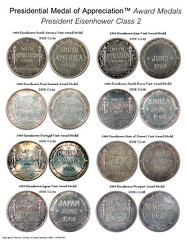 Darryl Gomez, author of Presidential Medal of Appreciation Awards 1958 – 1963 writes:
Darryl Gomez, author of Presidential Medal of Appreciation Awards 1958 – 1963 writes:
I'm a Money Talks speaker at the 2015 ANA World's Fair of Money this week. My presentation is on the medals. My time slot is August 15 at 2pm. I'm still working on my 45 min. presentation.
My incomplete set of medals was exhibited at the 2015 Spring Baltimore Expo and the 2015 Spring Pennsylvania Association of Numismatists (PAN) show. I received 2nd place at both shows.
I'm planning to display part of my collection at the session. I'm also bringing my copy of the source White House, Bureau of the Mint, and Philadelphia Mint records. The book has images of a few pages of the records.
To read the earlier E-Sylum articles, see:
NEW BOOK: PRESIDENTIAL MEDAL OF APPRECIATION
(www.coinbooks.org/esylum_v18n31a06.html)
OTHER 2015 ANA CONVENTION EVENTS (www.coinbooks.org/esylum_v18n30a21.html)
MORE 2015 ANA CONVENTION EVENTS (www.coinbooks.org/esylum_v18n31a39.html)
THE BOOK BAZARRE
A NIGHT AT THE SMITHSONIAN COIN EXHIBIT
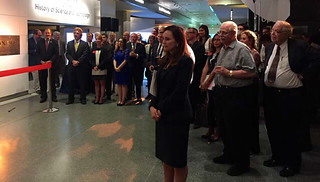 The evening of July 15, 2015 proved to be a treat for PAN President Tom Uram and Treasurer Pat McBride. It was the official opening of the
Smithsonian The Value of Money exhibition. The event started with a pleasant gathering of many notable numismatists with the sounds of a jazz
quartet, food, and drink. There was a definite excitement in the air that was put in motion by the imposing vault door that acts as the entrance to
the exhibit.
The evening of July 15, 2015 proved to be a treat for PAN President Tom Uram and Treasurer Pat McBride. It was the official opening of the
Smithsonian The Value of Money exhibition. The event started with a pleasant gathering of many notable numismatists with the sounds of a jazz
quartet, food, and drink. There was a definite excitement in the air that was put in motion by the imposing vault door that acts as the entrance to
the exhibit.
The newly elected ANA President Jeff Garrett made some opening remarks about the concept and creation of this wonderful exhibit. Jeff was one of the driving forces to see that the project was funded and carried to completion. His tireless effort was evident in the finished product. The official ribbon cutting was lead by the Treasurer of the United States Rosie Rios whose signature is present on all of our modern paper money today.
The theme of the numismatic material in the exhibit is the history of money from the early beginnings as feature by a Yap stone primitive money to the modern bit coin. Many may remember the past numismatic display of the Eli Lily gold coin collection. This exhibit is a little bit smaller and focuses on the evolvement of money through time. One very nice feature is the lighted pull drawers beneath the display cabinets that contain some delightful numismatic pieces. It is a very clever use of space and provides that sense of surprise when opening the drawer.
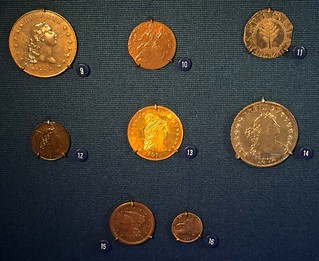
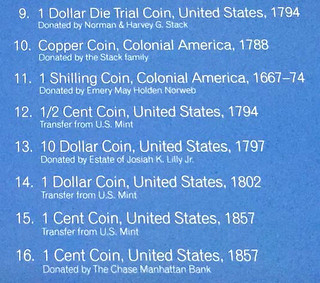
The collection includes coins but also paper money, rare numismatic literature, and ephemera. The objects on display are not just from the Smithsonian collection but include donations and loaned items from individuals, coin firms, and banks.
A few of the goodies in the Smithsonian exhibit are shown at the photo at right. How many can you identify? The identification chart is below. Take notice of the various donors. The numismatic exhibit is located in the Museum of American History building first floor and is not difficult to locate.
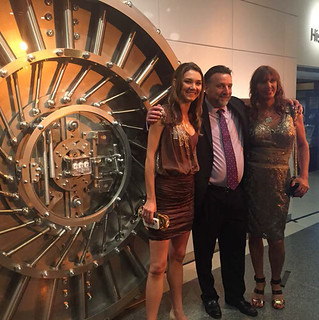 A last word about the vault door: Vault Structures, Inc. of Fort Meyers, FL built it. The door is a replica and is not functional as a
swinging door and lock. The purpose is for visual impact and that is what it certainly achieves. The photo shows company CEO Kevin McNamara with Sara
Cheney, head of design and development at right. Their company is the only company left in the world that still manufactures a round vault door. They
were very proud to be part of this project.
A last word about the vault door: Vault Structures, Inc. of Fort Meyers, FL built it. The door is a replica and is not functional as a
swinging door and lock. The purpose is for visual impact and that is what it certainly achieves. The photo shows company CEO Kevin McNamara with Sara
Cheney, head of design and development at right. Their company is the only company left in the world that still manufactures a round vault door. They
were very proud to be part of this project.
For more information on PAN, see:
www.pancoins.org
FUN WITH FREY: MODERN TAKES ON OLD COIN NAMES
Gary Beals writes:
Nearly a century on from Albert’s book we find he noted some things that have a different meaning to us now than they did to him a century ago.
LUSHBURGER: The best name for a new fast food franchise
Frey said: A false silver Penny from Luxemburg brought into England, in the reign of Edward III.
We say: Maybe so, but I am seeing neon signs, mounds of French fries, grilled meat and toasted buns.
SQUIDDISH: The coins most likely to be used by Harry Potter
Frey said: English slang in the 1800s for a small amount of money. In Northumberland it is a 20th of a farthing
We say: People needed change for a farthing, which itself was ¼ of a penny?
PRINGLES: Coin name most likely to become a factory-made snack
Frey said: A silver coin of 20 pence, struck in 1636 for Scotland.
We say: From silver coin to a crunchy snack made from a slurry of dried potatoes and salt? Pass me that can!
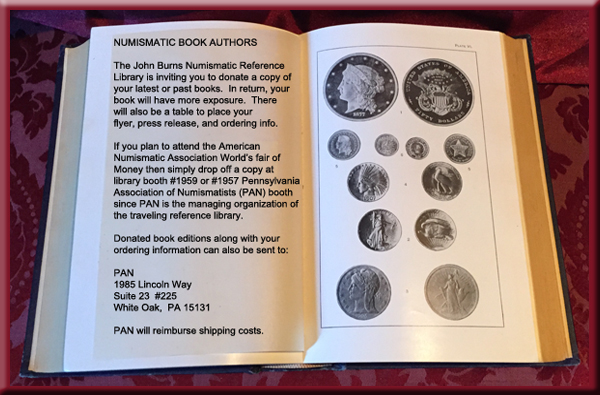
SYMBOLS ARTS MEDALS, CHALLENGE COINS, AND BADGES
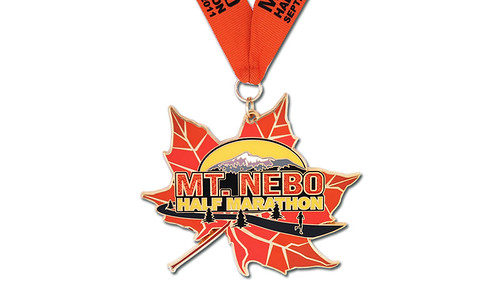
A footrace medal
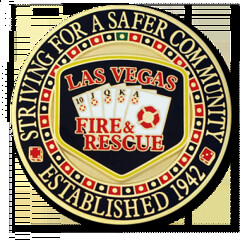
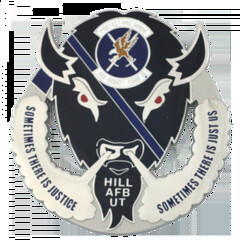
Challenge coins
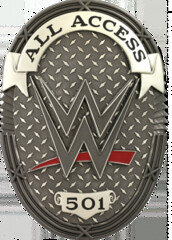 When the WWE contacted us to make a badge for their security services we let our artists run wild, brother!
When the WWE contacted us to make a badge for their security services we let our artists run wild, brother!
Jason Robinson, a leading production designer for the WWE, entrusted SymbolArts to design an all access security badge with attitude.
Oooh yeah! The attention to detail on this two tone 3-D badge is worthy of a king of the ring.
Those who wear it are certified stylin’, profilin’, limousine riding, jet flying, kiss-stealing, wheelin’ n’ dealin’ son of a guns!
For more information, see:
Designing the Perfect Challenge Coin
(www.symbolarts.com/2015/07/8179/designing-the-perfect-challenge-coin/)
Can you smell what SymbolArts is cookin?
(www.symbolarts.com/2015/07/8245/can-you-smell-what-symbolarts-is-cookin/)
THE BOOK BAZARRE
FEATURED WEB PAGE: THE ROSE STREET SUGAR HOUSE MEDAL
This week's Featured Web Page is an article from the Winter 2002 issue of ANS Magazine by Robert Hoge on Edward Groh's Rose Street Sugar House Medal. Coincidentally, the medal was created by engraver Emil Sigel, profiled in recent E-Sylum articles.The Sugar House was erected in 1763 on Prince Street (as Rose Street was formerly called) by Henry Cuyler. A wealthy Dutch family, the Cuylers were able to construct an impressive stone factory building. Undoubtedly, with six stories plus a basement, it was one of the largest buildings in the British Colonies. Original photographs taken before the demolition of the structure in 1892 confirm the medal's rendering: in the upper story of the house, the letters "BRC"—representing the initials of Henry Cuyler's son, Barent Rynders Cuyler—were worked into the façade in contrasting brick.
It is perhaps not surprising to find that Edward Groh, inspired by the history and myths of the Rhinelander Sugar House, commissioned this medal in 1892, the year of the demolition. The ANS records show that he had intended the subject to be part of Augustus Sage's Series of Historical Tokens relating to the Revolution.
In the year 1859. Mer Aug. B. Sage issued his Series of Historical Tokens and I suggested to him to include the Rose St Sugar house in the series which he agreed to do if I would furnish him with the drawing and before I could do so the series was discontinued. To my regret as I wished to see the building perpetuated on a medal, thirty three years later and before its demolition, I concluded to gratify my wish and Mr E. Sigel executed the work, The word Founded was not intended as I ordered it to be "erected" and the error is due to Mr Sigel to whom I exhibited the Sage Medalet of Liberty St Sugar house and he got the words mixed up. Edward Groh
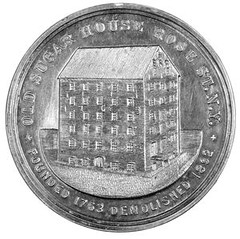
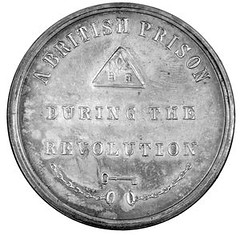
http://ansmagazine.com/Winter02/SugarHouse
